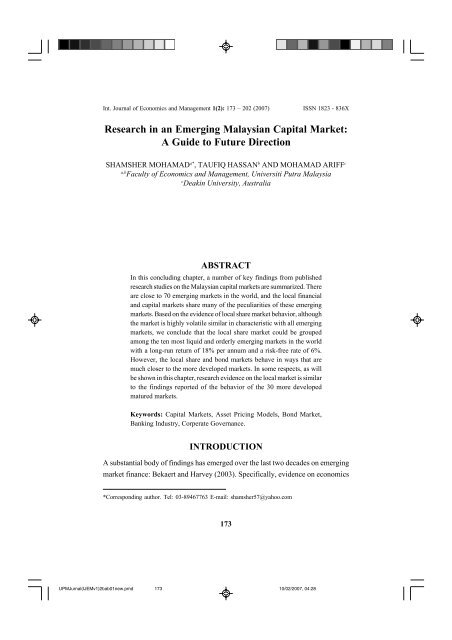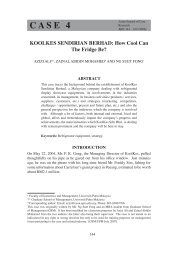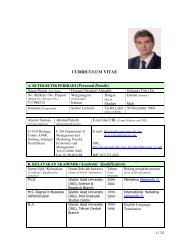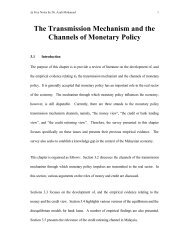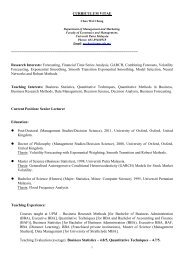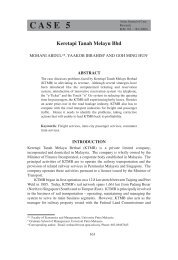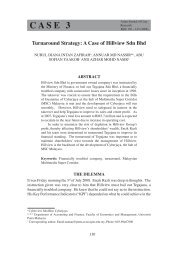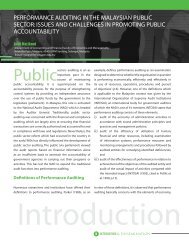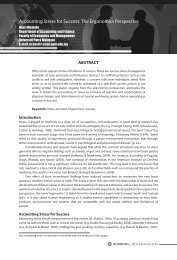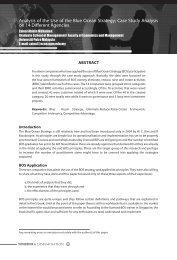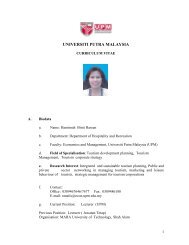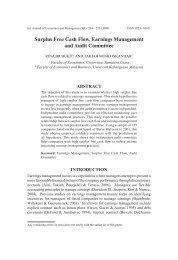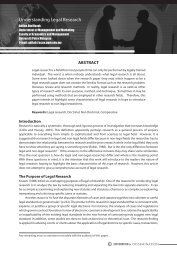Research in an Emerging Malaysian Capital Market: A Guide to ...
Research in an Emerging Malaysian Capital Market: A Guide to ...
Research in an Emerging Malaysian Capital Market: A Guide to ...
You also want an ePaper? Increase the reach of your titles
YUMPU automatically turns print PDFs into web optimized ePapers that Google loves.
Int. Journal <strong>Research</strong> of Economics <strong>in</strong> <strong>an</strong> Emerg<strong>in</strong>g <strong>an</strong>d M<strong>an</strong>agement Malaysi<strong>an</strong> 1(2): <strong>Capital</strong> 173 <strong>Market</strong>: – 202 (2007) A <strong>Guide</strong> <strong>to</strong> Future ISSN Direction 1823 - 836X<strong>Research</strong> <strong>in</strong> <strong>an</strong> Emerg<strong>in</strong>g Malaysi<strong>an</strong> <strong>Capital</strong> <strong>Market</strong>:A <strong>Guide</strong> <strong>to</strong> Future DirectionSHAMSHER MOHAMAD a* , TAUFIQ HASSAN b AND MOHAMAD ARIFF ca,bFaculty of Economics <strong>an</strong>d M<strong>an</strong>agement, Universiti Putra MalaysiacDeak<strong>in</strong> University, AustraliaABSTRACTIn this conclud<strong>in</strong>g chapter, a number of key f<strong>in</strong>d<strong>in</strong>gs from publishedresearch studies on the Malaysi<strong>an</strong> capital markets are summarized. Thereare close <strong>to</strong> 70 emerg<strong>in</strong>g markets <strong>in</strong> the world, <strong>an</strong>d the local f<strong>in</strong><strong>an</strong>cial<strong>an</strong>d capital markets share m<strong>an</strong>y of the peculiarities of these emerg<strong>in</strong>gmarkets. Based on the evidence of local share market behavior, althoughthe market is highly volatile similar <strong>in</strong> characteristic with all emerg<strong>in</strong>gmarkets, we conclude that the local share market could be groupedamong the ten most liquid <strong>an</strong>d orderly emerg<strong>in</strong>g markets <strong>in</strong> the worldwith a long-run return of 18% per <strong>an</strong>num <strong>an</strong>d a risk-free rate of 6%.However, the local share <strong>an</strong>d bond markets behave <strong>in</strong> ways that aremuch closer <strong>to</strong> the more developed markets. In some respects, as willbe shown <strong>in</strong> this chapter, research evidence on the local market is similar<strong>to</strong> the f<strong>in</strong>d<strong>in</strong>gs reported of the behavior of the 30 more developedmatured markets.Keywords: <strong>Capital</strong> <strong>Market</strong>s, Asset Pric<strong>in</strong>g Models, Bond <strong>Market</strong>,B<strong>an</strong>k<strong>in</strong>g Industry, Corperate Govern<strong>an</strong>ce.INTRODUCTIONA subst<strong>an</strong>tial body of f<strong>in</strong>d<strong>in</strong>gs has emerged over the last two decades on emerg<strong>in</strong>gmarket f<strong>in</strong><strong>an</strong>ce: Bekaert <strong>an</strong>d Harvey (2003). Specifically, evidence on economics*Correspond<strong>in</strong>g author. Tel: 03-89467763 E-mail: shamsher57@yahoo.com173UPMJurnal(IJEMv1)2bab01new.pmd 17310/02/2007, 04:28
International Journal of Economics <strong>an</strong>d M<strong>an</strong>agement<strong>an</strong>d f<strong>in</strong><strong>an</strong>cial <strong>in</strong>tegration <strong>an</strong>d on asset risk <strong>an</strong>d returns are found <strong>in</strong> Bekeart <strong>an</strong>dHarvey (1995); <strong>an</strong>d f<strong>in</strong>d<strong>in</strong>gs on the <strong>in</strong>tegration process, with reference <strong>to</strong> the speedof the <strong>in</strong>tegration process, are found <strong>in</strong> Edison <strong>an</strong>d Warnock (2003). Import<strong>an</strong>tf<strong>in</strong>d<strong>in</strong>gs on the ch<strong>an</strong>ges <strong>in</strong> pric<strong>in</strong>g behavior of asset returns, dividend yields, ch<strong>an</strong>ges<strong>in</strong> capital flows <strong>an</strong>d even market <strong>in</strong>frastructure for good govern<strong>an</strong>ce <strong>an</strong>d use ofaccount<strong>in</strong>g st<strong>an</strong>dards are found <strong>in</strong> Bakeart, et al. (2002) <strong>an</strong>d Bhattacharya <strong>an</strong>dDaouk (2002). There is also documentation of how <strong>in</strong>tegration impacts marketvolatility <strong>in</strong> Kim <strong>an</strong>d S<strong>in</strong>gal (2002), diversification <strong>an</strong>d contagion (Li, et al. 2003;Bae, et al. 2002), efficiency of emerg<strong>in</strong>g markets (Choe, et al. 2002), l<strong>in</strong>k betweenreal economy <strong>an</strong>d f<strong>in</strong><strong>an</strong>ce (Henry, 2000) <strong>an</strong>d the role of foreign <strong>in</strong>ves<strong>to</strong>rs <strong>in</strong>emerg<strong>in</strong>g markets economic crisis (Stiglitz, 2000).These <strong>an</strong>d other less known publications provide evidence contribut<strong>in</strong>g <strong>to</strong> abetter underst<strong>an</strong>d<strong>in</strong>g of how emerg<strong>in</strong>g markets are converg<strong>in</strong>g from less developed<strong>to</strong> emerg<strong>in</strong>g <strong>an</strong>d, <strong>in</strong> some cases, closer <strong>to</strong> developed market status. There is betterunderst<strong>an</strong>d<strong>in</strong>g of how capital markets are <strong>in</strong> fact nurtured <strong>to</strong> become more import<strong>an</strong>tfor capital mobilization <strong>in</strong> some import<strong>an</strong>t economies such as Ch<strong>in</strong>a, India, Egypt<strong>an</strong>d Pol<strong>an</strong>d. The actual market microstructure designed <strong>to</strong> nurture these markets <strong>to</strong>correctly sequence <strong>in</strong> the development process is better unders<strong>to</strong>od <strong>to</strong>day th<strong>an</strong> atearlier period. As the markets beg<strong>an</strong> <strong>to</strong> grow <strong>in</strong> liquidity <strong>an</strong>d <strong>in</strong>tegration with moredeveloped markets <strong>to</strong>ok place, there was a predictable impact on asset returns <strong>an</strong>drisk, volatility, <strong>in</strong>formational efficiency <strong>an</strong>d also the improved liquidity that comesfrom flow of capital <strong>to</strong> markets with a more liberal bend. In essence, the developmentprocess reduces, <strong>to</strong> some extent, the risk of spikes <strong>in</strong> contagion from crisis hitt<strong>in</strong>ga particular market.There are opportunities <strong>to</strong> further subst<strong>an</strong>tiate or provide new evidence oncosts of capital <strong>in</strong> these markets <strong>an</strong>d the impact of f<strong>in</strong><strong>an</strong>cial, legal <strong>an</strong>dmacroeconomic reforms <strong>in</strong> these newly evolv<strong>in</strong>g markets (Eichengreen, 2001, Beim<strong>an</strong>d Calomiris, 2001). There are policy issues of how best <strong>to</strong> optimize the sequenc<strong>in</strong>gof reform <strong>an</strong>d its impact on the economic growth <strong>an</strong>d capital mobilization prospectsof the countries (Edwards, 1987). The <strong>in</strong>stitutional, legal <strong>an</strong>d regula<strong>to</strong>ryrequirements <strong>an</strong>d their impacts on asset returns <strong>an</strong>d prices are found <strong>in</strong> Cherkaoui<strong>an</strong>d Ghysels (2003) <strong>an</strong>d the impact from liberalization efforts, at firm level, isfound <strong>in</strong> Chari <strong>an</strong>d Henry (2001). The agency issues <strong>in</strong> the firms (see Harvey,174UPMJurnal(IJEMv1)2bab01new.pmd 17410/02/2007, 04:28
<strong>Research</strong> <strong>in</strong> <strong>an</strong> Emerg<strong>in</strong>g Malaysi<strong>an</strong> <strong>Capital</strong> <strong>Market</strong>: A <strong>Guide</strong> <strong>to</strong> Future Directionet al. 2002), political risks <strong>an</strong>d its relationship with f<strong>in</strong><strong>an</strong>cial reforms <strong>an</strong>d economicgrowth <strong>in</strong> emerg<strong>in</strong>g markets (see Das <strong>an</strong>d Mohapatra, 2002) <strong>an</strong>d the impact ofliberalization (see Qu<strong>in</strong>n, et al. 2001) are also policy issues which are now betterunders<strong>to</strong>od due <strong>to</strong> these studies.While the discussion <strong>to</strong> this po<strong>in</strong>t has focused on emerg<strong>in</strong>g markets <strong>in</strong> general,we need <strong>to</strong> assess the evidence from capital market research <strong>in</strong> Malaysia <strong>in</strong> the res<strong>to</strong>f the paper. Most of the documented evidence discussed is sourced from studiesthat address the relev<strong>an</strong>t issues <strong>in</strong> multiple countries, as competition has made itdifficult <strong>to</strong> publish s<strong>in</strong>gle country studies <strong>in</strong> <strong>to</strong>p refereed journals. This paper focuseson as the Malaysi<strong>an</strong> capital market behavior us<strong>in</strong>g ma<strong>in</strong>stream ideas <strong>in</strong> f<strong>in</strong><strong>an</strong>ce.Specifically, issues relat<strong>in</strong>g <strong>to</strong> exch<strong>an</strong>ge rate, efficiency, asset pric<strong>in</strong>g <strong>an</strong>dderivatives, the special behavior of the b<strong>an</strong>k<strong>in</strong>g sec<strong>to</strong>r, the f<strong>in</strong><strong>an</strong>cial m<strong>an</strong>agementsec<strong>to</strong>r, <strong>in</strong>vestment m<strong>an</strong>agement sec<strong>to</strong>r, <strong>an</strong>d account<strong>in</strong>g, audit<strong>in</strong>g <strong>an</strong>d govern<strong>an</strong>ceissues are exam<strong>in</strong>ed.THEORY BASED RESEARCHEquity <strong>Market</strong>sMost theories about capital market behavior orig<strong>in</strong>ated whilst study<strong>in</strong>g developedmarkets with long his<strong>to</strong>ries. Emerg<strong>in</strong>g markets <strong>in</strong> general <strong>an</strong>d the Malaysi<strong>an</strong> market<strong>in</strong> particular have short his<strong>to</strong>ries, <strong>an</strong>d are characteristically different from developedmarkets. The emerg<strong>in</strong>g markets, therefore, provide opportunity <strong>to</strong> validatedeveloped market theories <strong>in</strong> new market sett<strong>in</strong>gs. F<strong>in</strong><strong>an</strong>ce theoretici<strong>an</strong>s havedeveloped equilibrium pric<strong>in</strong>g theories us<strong>in</strong>g the classical approach of supplydem<strong>an</strong>d<strong>an</strong>alysis. These <strong>in</strong>clude CAPM, APT, Multi-<strong>in</strong>dex Model, S<strong>in</strong>gle IndexModel, Options Theory <strong>an</strong>d Consumption-based CAPM which exam<strong>in</strong>e securitiespric<strong>in</strong>g <strong>in</strong> market places. These are core theories <strong>in</strong> f<strong>in</strong><strong>an</strong>ce, <strong>an</strong>d are widely applied<strong>in</strong> professional practice <strong>an</strong>d academic tra<strong>in</strong><strong>in</strong>g.<strong>Capital</strong> Asset Pric<strong>in</strong>g Model (CAPM)The CAPM predicts that asset returns are positively correlated with asset riskmeasured as systematic risk <strong>to</strong> test the risk-return relationship, risk measures mustbe stable (this is likely if risk is measured over a lengthy <strong>in</strong>terval) <strong>an</strong>d these must175UPMJurnal(IJEMv1)2bab01new.pmd 17510/02/2007, 04:28
International Journal of Economics <strong>an</strong>d M<strong>an</strong>agementbe corrected for non-synchronous errors. Ariff, et al. (1998) tested the relationshipbetween portfolio returns <strong>an</strong>d portfolio risk <strong>in</strong> Malaysia’s emerg<strong>in</strong>g capital market.The variables specified as <strong>in</strong>dependent are beta <strong>an</strong>d beta-squared measures whilethe control variables are size, leverage, earn<strong>in</strong>gs-price ratio <strong>an</strong>d book-<strong>to</strong>-marketequity ratios obta<strong>in</strong>ed from a sample of 60 <strong>in</strong>dustrial firms listed <strong>an</strong>d traded over arecent 15-year period. It was found that only beta, beta-squared <strong>an</strong>d size variablesare signific<strong>an</strong>t <strong>in</strong> expla<strong>in</strong><strong>in</strong>g s<strong>to</strong>ck returns. The negative effect <strong>in</strong> risk-return tradeoffwith beta-squared values <strong>an</strong>d size is not acceptable, while the positive effectfrom beta is consistent with theory. Hence, there is a need for more carefullyconstructed tests us<strong>in</strong>g a longer time frame <strong>an</strong>d a larger sample <strong>to</strong> further validatethe <strong>in</strong>sights on the behavioral aspect of s<strong>to</strong>ck returns <strong>an</strong>d its determ<strong>in</strong><strong>an</strong>ts. There isalso a need <strong>to</strong> further validate the Arbitrage Pric<strong>in</strong>g Model (APT), which is <strong>an</strong>extension of the CAPM <strong>an</strong>d overcomes some of the basic flaws <strong>in</strong> CAPM.Arbitrage Pric<strong>in</strong>g Model (APT)Lim (2005) tested the applicability of the APT on s<strong>to</strong>cks listed on the Kuala LumpurS<strong>to</strong>ck Exch<strong>an</strong>ge, KLSE (Bursa Malaysia) by identify<strong>in</strong>g both macroeconomic <strong>an</strong>dfirm-specific fac<strong>to</strong>rs which are correlated with price ch<strong>an</strong>ges. The f<strong>in</strong>d<strong>in</strong>gssupported a conclusion that there is a weak applicability of APT <strong>in</strong> this market forthe data over a 21-year period. This f<strong>in</strong>d<strong>in</strong>g is consistent with Hossari (1994)who found only one fac<strong>to</strong>r for the Malaysi<strong>an</strong> market us<strong>in</strong>g a one-year test w<strong>in</strong>dow.Further research is therefore warr<strong>an</strong>ted <strong>in</strong> this area, with lengthier test w<strong>in</strong>dows,us<strong>in</strong>g ref<strong>in</strong>ed measures <strong>an</strong>d robust methodology such as the one used by Limop cit. For example, although a wide r<strong>an</strong>ge of commonly reported economic <strong>an</strong>df<strong>in</strong><strong>an</strong>cial variables were used, the relev<strong>an</strong>t variables had not been identified(although this is not very likely as the variables chosen are the ma<strong>in</strong> economic<strong>in</strong>dica<strong>to</strong>rs observed by market players). The fac<strong>to</strong>rs identified by fac<strong>to</strong>r <strong>an</strong>alysisdo not exactly correspond <strong>to</strong> economic variables as these are a comb<strong>in</strong>ation ofvariables. Further, macroeconomic variables are measured with much noise(see Wasserfallen, 1989), <strong>an</strong>d as such the coefficients are measured with errors <strong>in</strong>the first stage regression result<strong>in</strong>g <strong>in</strong> the errors-<strong>in</strong>-variables problem <strong>in</strong> thesecond stage regression. However, tests of APT are sensitive <strong>to</strong> the different<strong>an</strong>alytical <strong>to</strong>ols used. A large number of these <strong>to</strong>ols are cited <strong>in</strong> literature: Full176UPMJurnal(IJEMv1)2bab01new.pmd 17610/02/2007, 04:28
<strong>Research</strong> <strong>in</strong> <strong>an</strong> Emerg<strong>in</strong>g Malaysi<strong>an</strong> <strong>Capital</strong> <strong>Market</strong>: A <strong>Guide</strong> <strong>to</strong> Future DirectionInformation Maximum Likelihood or FIML c<strong>an</strong>onical correlations <strong>an</strong>d co<strong>in</strong>tegration.Efficient <strong>Market</strong> Theory (EMH)The concept of <strong>an</strong> efficient market describes time series <strong>in</strong>dependence of priceformation <strong>in</strong> a competitive market <strong>in</strong> addition <strong>to</strong> prices react<strong>in</strong>g rapidly <strong>to</strong> r<strong>an</strong>domlyarriv<strong>in</strong>g <strong>in</strong>formation (Fama, 1991). This basic idea is widely applied <strong>to</strong> emerg<strong>in</strong>gmarkets <strong>to</strong> verify how <strong>in</strong>formation relat<strong>in</strong>g <strong>to</strong> shares <strong>in</strong> th<strong>in</strong>ly-traded emerg<strong>in</strong>gmarkets is captured with a time delay. Traditional tests of <strong>in</strong>formational efficiency<strong>in</strong>dicate that <strong>an</strong>y competitive capital market is broadly efficient although reportsof signific<strong>an</strong>t but unexploitable systematic <strong>an</strong>omalies cont<strong>in</strong>ue <strong>to</strong> challenge thisidea <strong>in</strong> several markets when compared with the more established capital marketswith sufficient levels of efficiency. The efficiency of this market has been welldocumented (Annuar, 1990; Annuar, et al. 1992) but previous studies conductedused small samples with short time sp<strong>an</strong>s, <strong>an</strong>d are hence unreliable.Annuar, et al. (1994) conducted a weak <strong>an</strong>d semi-strong form efficiency studyaddress<strong>in</strong>g all the crucial identifiable weaknesses of previous studies <strong>an</strong>d reportedthat the Bursa Malaysia market is generally efficient though there are pockets of<strong>in</strong>efficiencies at the marg<strong>in</strong>s. Kok <strong>an</strong>d Goh (1994) also documented evidence ofweak-form efficiency us<strong>in</strong>g monthly data for the period 1984-1992: if a market isnot shown <strong>to</strong> be efficient on a daily basis, it is useless <strong>to</strong> show weak-form efficiency<strong>in</strong> <strong>an</strong>y lengthier <strong>in</strong>tervals. They show that KLSE generally tr<strong>an</strong>sformed fromweak-form <strong>in</strong>efficiency <strong>in</strong> the mid-1980s <strong>to</strong> weak form efficiency by the early1990s.Further validation of the results could be done by us<strong>in</strong>g better models, largersamples <strong>an</strong>d longer time periods <strong>an</strong>d test<strong>in</strong>g for speed of adjustment of <strong>in</strong>formation<strong>in</strong> share prices. Documented evidence suggests two prom<strong>in</strong>ent features of priceformation <strong>in</strong> most emerg<strong>in</strong>g markets (Ariff <strong>an</strong>d Johnson, 1990): signific<strong>an</strong>t overreactions<strong>to</strong> <strong>in</strong>formation <strong>an</strong>d slow speed of adjustment <strong>to</strong> <strong>in</strong>formation. In this respect,Jothee (2006) tested the speed of adjustment <strong>to</strong> materially sensitive <strong>in</strong>formationfrom import<strong>an</strong>t public <strong>an</strong>nouncements of selected macro <strong>an</strong>d micro events. Hedocumented that it takes as long as a week for macro <strong>in</strong>formation <strong>to</strong> be absorbed,which, if true, is slower th<strong>an</strong> price reactions observed <strong>in</strong> the Hong Kong <strong>an</strong>d Tokyo177UPMJurnal(IJEMv1)2bab01new.pmd 17710/02/2007, 04:28
International Journal of Economics <strong>an</strong>d M<strong>an</strong>agementmarkets. Given the lack of speed <strong>in</strong> price responses <strong>to</strong> new <strong>in</strong>formation, furtherresearch should exam<strong>in</strong>e the reasons for the impediment <strong>to</strong> efficient formation ofprices.Asset Valuation or Discounted Cash Flow Models (DCF)The valuation paradigm suggests a broad-based pr<strong>in</strong>ciple that the value of a f<strong>in</strong><strong>an</strong>cialasset is the sum of the present values of expected future cash flows from <strong>an</strong> assetdiscounted at the risk level appropriate for the cash flows. Hence, <strong>in</strong> valu<strong>in</strong>gsecurities, Gordon’s Dividend Valuation Model (DVM), is widely used <strong>in</strong> appliedf<strong>in</strong><strong>an</strong>ce. This valuation model assumes that the fundamentals <strong>in</strong>corporated <strong>in</strong> thevaluation theorems ought <strong>to</strong> price securities <strong>in</strong> <strong>an</strong>y market. If the idea is true, thena test <strong>to</strong> ascerta<strong>in</strong> if the fundamentals <strong>in</strong>corporated <strong>in</strong> the valuation models are<strong>in</strong>deed driv<strong>in</strong>g the security prices could be carried out. It has been shown that thefundamental fac<strong>to</strong>rs are related <strong>to</strong> share price ch<strong>an</strong>ges: Ariff, et al. (1995). It wasshown that ch<strong>an</strong>ges <strong>in</strong> six fundamental fac<strong>to</strong>rs are highly correlated with ch<strong>an</strong>ges<strong>in</strong> share prices <strong>in</strong> this market: <strong>in</strong> a reduced model it was shown that just 3 variablesexpla<strong>in</strong> 26 per cent of the variation <strong>in</strong> share prices.This creates great concern among <strong>in</strong>ves<strong>to</strong>rs <strong>an</strong>d others such as s<strong>to</strong>ckbrokers,fund m<strong>an</strong>agers <strong>an</strong>d <strong>in</strong>vestment <strong>an</strong>alysts. Ariff, et al. (1998) addressed the issue ofwhether the DVM (Gordon, 1962) could expla<strong>in</strong> share price ch<strong>an</strong>ges <strong>in</strong> this market.They documented that the non-l<strong>in</strong>ear Gordon’s model is able <strong>to</strong> expla<strong>in</strong>, <strong>in</strong> excessof 60 per cent, the ch<strong>an</strong>ges <strong>in</strong> share prices. This is startl<strong>in</strong>g <strong>in</strong> that the model isrelev<strong>an</strong>t <strong>an</strong>d more so <strong>in</strong> its non-l<strong>in</strong>ear form. This appears <strong>to</strong> suggest that Gordon’smodel with its book value measure of required rate of return on equity (k) c<strong>an</strong> bereliably used by <strong>in</strong>ves<strong>to</strong>rs <strong>to</strong> value common s<strong>to</strong>ck prices <strong>in</strong> this market.However, Imbar<strong>in</strong>e (2006) suggests that the DVM is the best method <strong>to</strong> appraises<strong>to</strong>ck price dur<strong>in</strong>g bearish markets, for example dur<strong>in</strong>g <strong>an</strong> economic crisis. TheEarn<strong>in</strong>g Multiplier Model or the Price-Earn<strong>in</strong>g Model approach rema<strong>in</strong>s popularamong <strong>an</strong>alysts as they believe that dividends <strong>an</strong>d earn<strong>in</strong>gs are the ma<strong>in</strong> predic<strong>to</strong>rs<strong>in</strong> these valuation techniques. It is import<strong>an</strong>t <strong>to</strong> <strong>in</strong>vestigate other valuationtechniques that are relev<strong>an</strong>t for all economic conditions. Further tests over a longerperiod <strong>an</strong>d probably more variables could be used <strong>to</strong> further validate the applicabilityof the Gordon model <strong>in</strong> pric<strong>in</strong>g shares <strong>in</strong> this market. It is also <strong>in</strong>terest<strong>in</strong>g <strong>to</strong> ascerta<strong>in</strong>178UPMJurnal(IJEMv1)2bab01new.pmd 17810/02/2007, 04:28
Affordable Rental Hous<strong>in</strong>g Program (AHP) OverviewThe Affordable Rental Hous<strong>in</strong>g Program (AHP) offers $18.9 million 1 for the follow<strong>in</strong>gtargeted activities <strong>in</strong> the Eligible Counties:1. Public Hous<strong>in</strong>g Rehabilitation –small capital gr<strong>an</strong>ts for public hous<strong>in</strong>g rehabilitation,energy, <strong>an</strong>d accessibility improvements;2. USDA Rural Development Acquisition/Rehabilitation – capital improvement gr<strong>an</strong>ts forpreservation of US Department of Agriculture – Rural Development rental developments<strong>in</strong> rural communities;3. Perm<strong>an</strong>ent Supportive Hous<strong>in</strong>g – new construction or rehabilitation of hous<strong>in</strong>g units forpersons with disabilities <strong>an</strong>d households that are homeless or at-risk of homelessness;4. Small Rental Properties Program; <strong>an</strong>d5. Fund<strong>in</strong>g for the new construction <strong>an</strong>d rehabilitation of rental hous<strong>in</strong>g.AHP will support repairs, rehabilitation, reconstruction, <strong>an</strong>d new construction of the affordablerental hous<strong>in</strong>g s<strong>to</strong>ck <strong>in</strong> Eligible Counties. To adm<strong>in</strong>ister the affordable rental hous<strong>in</strong>g set-asidemost effectively <strong>an</strong>d efficiently, especially when leverag<strong>in</strong>g with other federal <strong>an</strong>d State ofIll<strong>in</strong>ois assist<strong>an</strong>ce programs, the Authority will work directly with non-profit <strong>an</strong>d for-profitproperty owners as applic<strong>an</strong>ts <strong>an</strong>d subsequent gr<strong>an</strong>tees or borrowers.One major priority under AHP is <strong>to</strong> first consider assist<strong>in</strong>g exist<strong>in</strong>g properties that, assum<strong>in</strong>gcompli<strong>an</strong>ce with floodpla<strong>in</strong> requirements described elsewhere (Section 2: ApplicationSubmission <strong>an</strong>d Evaluation) <strong>in</strong> this Request for Applications, either1) susta<strong>in</strong>ed damages due <strong>to</strong> s<strong>to</strong>rms, flood<strong>in</strong>g, hurric<strong>an</strong>es <strong>an</strong>d other natural disasters tha<strong>to</strong>ccurred <strong>in</strong> 2008, or 2) could positively benefit from rehabilitation work <strong>in</strong>volv<strong>in</strong>g flood-proof<strong>in</strong>g<strong>an</strong>d related mitigation efforts that would serve <strong>to</strong> reduce or elim<strong>in</strong>ate the impact of futurenatural disasters.All applications for affordable rental hous<strong>in</strong>g construction or rehabilitation funds are subject <strong>to</strong>a competitive selection process. This will <strong>in</strong>clude the use of the Authority’s CDBG-DRApplications, found at www.ihda.org under Multifamily Programs CommunityDevelopment Block Gr<strong>an</strong>t “Ike” Program. The Authority will also review specific m<strong>an</strong>da<strong>to</strong>ryproject threshold requirements as set forth below.The Authority will release separate application guidel<strong>in</strong>es for each of the targeted activitiesunder the AHP. The follow<strong>in</strong>g Application <strong>Guide</strong>l<strong>in</strong>es cover only the Public Hous<strong>in</strong>gRehabilitation targeted activity under the AHP.1Redistribution of AHP Gr<strong>an</strong>ts/Lo<strong>an</strong>s: With<strong>in</strong> the five specific sub-categories of fund<strong>in</strong>g for the AHP,the amounts allocated under each serve as estimates only, <strong>an</strong>d will be adjusted as the selectionprocess concludes <strong>an</strong>d fund<strong>in</strong>g decisions are f<strong>in</strong>alized <strong>to</strong> reflect the actual dollar amounts utilized persubcategory. There may be a larger dem<strong>an</strong>d or larger field of ready-<strong>to</strong>-proceed projects <strong>in</strong> onesubcategory over <strong>an</strong>other that will warr<strong>an</strong>t the redistribution of proposed allocations.6
International Journal of Economics <strong>an</strong>d M<strong>an</strong>agementall the emerg<strong>in</strong>g markets. For example Korea has 22 percent <strong>in</strong> corporate bonds:Thail<strong>an</strong>d has 13.6 percent: S<strong>in</strong>gapore has 31.6 percent: Malaysia has 37.3 percent.In the last case the <strong>to</strong>tal value of government <strong>an</strong>d corporate bonds is almost equaleven though corporate bonds were issued only after year 1999 (IMF work<strong>in</strong>g paperNo: 152, 2005). There are numerous research issues that could be explored <strong>in</strong> thecorporate bond market. For example, the validity of the rat<strong>in</strong>g assigned by rat<strong>in</strong>gagencies, the predictive ability of yield curves from these bonds <strong>an</strong>d the relationshipbetween Treasury bond yields <strong>an</strong>d corporate bond yields. More sophisticatedapplied research could search for the price value of re-rat<strong>in</strong>g of comp<strong>an</strong>ies, <strong>an</strong>dthe spread between different rat<strong>in</strong>gs. A const<strong>an</strong>t compla<strong>in</strong> is that the rat<strong>in</strong>gs givenby local rat<strong>in</strong>g agencies <strong>an</strong>d the <strong>in</strong>ternational agencies are signific<strong>an</strong>tly different.If that is true, the price premiums for the rat<strong>in</strong>gs must be different, a <strong>to</strong>pic for avery useful study.Derivatives <strong>Market</strong>sThere is a rush <strong>to</strong> <strong>in</strong>troduce more derivative securities <strong>in</strong> emerg<strong>in</strong>g markets, despitethe documented losses suffered by established enterprises dabbl<strong>in</strong>g <strong>in</strong> futurescontracts (<strong>in</strong> Ch<strong>in</strong>a, Malaysia, United States, Germ<strong>an</strong>y, United K<strong>in</strong>gdom <strong>an</strong>dIndonesia) <strong>an</strong>d the failures of m<strong>an</strong>y futures contracts <strong>in</strong> exch<strong>an</strong>ges (Hong Kong<strong>an</strong>d S<strong>in</strong>gapore). The push for <strong>in</strong>troduction of derivatives is <strong>to</strong> attract <strong>in</strong>stitutional<strong>in</strong>ves<strong>to</strong>rs <strong>an</strong>d <strong>in</strong>crease the liquidity <strong>in</strong> the market, as these <strong>in</strong>ves<strong>to</strong>rs usually resort<strong>to</strong> derivative contracts <strong>to</strong> m<strong>an</strong>age their <strong>in</strong>vestment risk. Should the spot market’sprice risk <strong>in</strong>crease, they could hedge their position us<strong>in</strong>g contracts <strong>in</strong> the futures markets.It makes good economic sense, from their po<strong>in</strong>ts of view, <strong>to</strong> justify futures markets.The three key issues <strong>in</strong> the feasibility of futures <strong>in</strong>struments are: dem<strong>an</strong>d,underly<strong>in</strong>g market resilience for price discovery <strong>an</strong>d the overall contribution <strong>to</strong>risk m<strong>an</strong>agement. It is a foregone conclusion <strong>in</strong> f<strong>in</strong><strong>an</strong>cial economics that viabledem<strong>an</strong>d for derivatives requires (a) speculative dem<strong>an</strong>d <strong>to</strong> reveal prices <strong>an</strong>d (b)hedge dem<strong>an</strong>d <strong>to</strong> create opposite positions. In the local market, commodity futurescontracts on plam oil <strong>an</strong>d rubber have been traded for almost three decades withspecula<strong>to</strong>rs provid<strong>in</strong>g liquidity for producers <strong>to</strong> cover price risk, result<strong>in</strong>g <strong>in</strong> veryefficient pric<strong>in</strong>g of commodities (this is despite the failure of T<strong>in</strong> market <strong>in</strong> the1970s). The f<strong>in</strong><strong>an</strong>cial derivative contracts started <strong>in</strong> the mid-1990s.180UPMJurnal(IJEMv1)2bab01new.pmd 18010/02/2007, 04:28
<strong>Research</strong> <strong>in</strong> <strong>an</strong> Emerg<strong>in</strong>g Malaysi<strong>an</strong> <strong>Capital</strong> <strong>Market</strong>: A <strong>Guide</strong> <strong>to</strong> Future DirectionThere is scarcity of evidence on the pric<strong>in</strong>g efficiency of Malaysi<strong>an</strong> DerivativesExch<strong>an</strong>ge (or MDEX) traded <strong>in</strong>struments. Abdul, et al. (1999) exam<strong>in</strong>ed severalissues related <strong>to</strong> the <strong>in</strong>troduction <strong>an</strong>d trad<strong>in</strong>g of s<strong>to</strong>ck <strong>in</strong>dex futures contracts. Theydocument no evidence of <strong>in</strong>creas<strong>in</strong>g volatility, expiration date effect, mispric<strong>in</strong>g<strong>an</strong>d no lead-lag relationship between the s<strong>to</strong>ck market <strong>an</strong>d futures market. Taufiq,et al. (2007a) documented evidence on the pric<strong>in</strong>g of s<strong>to</strong>ck <strong>in</strong>dex futures contracttraded on the MDEX. The latter study <strong>to</strong>ok <strong>in</strong><strong>to</strong> consideration tr<strong>an</strong>saction costs<strong>an</strong>d different regula<strong>to</strong>ry regimes before <strong>an</strong>d after the 1997-8 f<strong>in</strong><strong>an</strong>cial crisis <strong>an</strong>dthe capital control regimes. They reported that the difference between the actualprice <strong>an</strong>d theoretical price of contracts is small <strong>an</strong>d that the deviations becamevery large immediately after the f<strong>in</strong><strong>an</strong>cial crisis, for the most cases, <strong>in</strong> one direction.The actual futures prices became lower th<strong>an</strong> the theoretical price. Tr<strong>an</strong>saction costshad little <strong>in</strong>fluence on this deviation. The behavior is expla<strong>in</strong>ed as the traders’jo<strong>in</strong>t efforts <strong>to</strong> widen the spread when risk suddenly <strong>in</strong>creased as a result of <strong>an</strong>unexpected f<strong>in</strong><strong>an</strong>cial crisis. Mispric<strong>in</strong>g tended <strong>to</strong> decrease when the contractapproached expiration date hence limit<strong>in</strong>g arbitrage opportunity, as is the case <strong>in</strong>developed markets as well.Mahadhir, et al. (2002) exam<strong>in</strong>ed the temporal relationship between the pricecommon s<strong>to</strong>ck futures contract (FKLI) <strong>an</strong>d its underly<strong>in</strong>g s<strong>to</strong>ck <strong>in</strong>dex, the KLSECI. The five-year test period was split <strong>in</strong><strong>to</strong> three sub-periods <strong>to</strong> observe the priceco-movement patterns under different volatility levels. The f<strong>in</strong>d<strong>in</strong>gs suggest thatthe futures market tends <strong>to</strong> lead the spot market by one day dur<strong>in</strong>g periods ofstable market conditions: there was a mixed lead-lag relationship between the twomarkets dur<strong>in</strong>g periods of high market volatility.Taufiq, et al. (2006) documented the pric<strong>in</strong>g behavior of <strong>in</strong>terest rate futurescontracts i.e. the 3-month KLIBOR futures contract. Evidence <strong>in</strong>dicates that thelevel of mispric<strong>in</strong>g for shorter maturities is m<strong>in</strong>imal compared <strong>to</strong> long maturitycontracts. It was also observed that the f<strong>in</strong><strong>an</strong>cial crisis had m<strong>in</strong>imal impact on thepric<strong>in</strong>g of KLIBOR futures contracts. However, these contracts lack liquidityprobably due <strong>to</strong> m<strong>an</strong>aged <strong>in</strong>terest rate policies implemented s<strong>in</strong>ce the onset of thef<strong>in</strong><strong>an</strong>cial crisis, <strong>an</strong>d perhaps also due <strong>to</strong> the absence of <strong>in</strong>stitutional <strong>in</strong>terest <strong>in</strong> thismarket compounded by lack of awareness <strong>an</strong>d also lack of confidence <strong>to</strong> use thesecontracts for hedg<strong>in</strong>g <strong>in</strong>terest rate risks.181UPMJurnal(IJEMv1)2bab01new.pmd 18110/02/2007, 04:28
International Journal of Economics <strong>an</strong>d M<strong>an</strong>agementTaufiq, et al. (2007b) <strong>an</strong>alyzed the <strong>in</strong>formational efficiency of Crude PalmOil (CPO) futures contracts by separat<strong>in</strong>g the futures prices accord<strong>in</strong>g <strong>to</strong> theirmaturity life cycles. If futures price formation follows rational expectations, then<strong>in</strong>formation will flow from futures <strong>to</strong> spot <strong>an</strong>d not the other way around. Theresults are generally consistent with the expectations. All dist<strong>an</strong>t month error terms<strong>in</strong> spot equations are statistically signific<strong>an</strong>t for three sub-period samples (1987-89, 1990-92 <strong>an</strong>d 1996-98). The f<strong>in</strong>d<strong>in</strong>gs are consistent with the notion that allexpectations will converge <strong>in</strong> the term<strong>in</strong>al month prices <strong>an</strong>d the spot market playsa dom<strong>in</strong><strong>an</strong>t role, along with futures, <strong>in</strong> adjust<strong>in</strong>g prices. These f<strong>in</strong>d<strong>in</strong>gs are similar<strong>to</strong> those observed <strong>in</strong> more developed commodity futures markets.Documented evidence on the local derivatives markets is scarce <strong>an</strong>d there arelots of opportunities for further research on these f<strong>in</strong><strong>an</strong>cial derivative markets <strong>an</strong>dthe relatively matured commodities futures markets. There are now new productsbe<strong>in</strong>g <strong>in</strong>troduced such as the option on the s<strong>to</strong>ck <strong>in</strong>dex <strong>an</strong>d the 5-year MGS <strong>an</strong>dthe options on selected s<strong>to</strong>ck counters traded on the ma<strong>in</strong> board. There are criticalissues that need <strong>to</strong> be addressed <strong>to</strong> make the derivatives markets relev<strong>an</strong>t for global<strong>in</strong>ves<strong>to</strong>rs as is the case <strong>in</strong> the Hong Kong <strong>an</strong>d Kore<strong>an</strong> markets which started atabout the same time as the Malaysi<strong>an</strong> market but are already attract<strong>in</strong>g globalplayers with good liquidity. For example, the equity <strong>in</strong>dex futures contract <strong>in</strong> Koreahas the highest liquidity <strong>in</strong> the world.Systematic Risk <strong>an</strong>d Th<strong>in</strong> Trad<strong>in</strong>gThe Malaysi<strong>an</strong> market is a th<strong>in</strong>ly-traded market <strong>an</strong>d consequently there is nonsynchronoustrad<strong>in</strong>g bias on prices. Estimate of parameters <strong>in</strong> asset pric<strong>in</strong>g modelsbased on <strong>in</strong>formation from these markets are usually <strong>in</strong>accurate <strong>an</strong>d require someadjustments <strong>to</strong> <strong>in</strong>crease the validity of parameters. Ariff <strong>an</strong>d Johnson (1990) showeda correction procedure <strong>to</strong> correct these errors <strong>an</strong>d <strong>in</strong>vestigated the relative efficiencyof different methods for correct<strong>in</strong>g the bias, while also identify<strong>in</strong>g the optimal lags<strong>an</strong>d leads required <strong>in</strong> the adjustment procedure <strong>in</strong> the S<strong>in</strong>gapore <strong>an</strong>d Malaysi<strong>an</strong>s<strong>to</strong>ck markets. The Fowler <strong>an</strong>d Rorke method specify<strong>in</strong>g three lags <strong>an</strong>d leads wasfound <strong>to</strong> be relatively more efficient. They extended the Fowler <strong>an</strong>d Rorke’s twolag/lead equation <strong>to</strong> a three lag/lead equation for application <strong>in</strong> a very illiquidmarket. With the signific<strong>an</strong>t ch<strong>an</strong>ges <strong>in</strong> the market microstructure after the 1997-182UPMJurnal(IJEMv1)2bab01new.pmd 18210/02/2007, 04:28
<strong>Research</strong> <strong>in</strong> <strong>an</strong> Emerg<strong>in</strong>g Malaysi<strong>an</strong> <strong>Capital</strong> <strong>Market</strong>: A <strong>Guide</strong> <strong>to</strong> Future Direction8 f<strong>in</strong><strong>an</strong>cial crisis, it would be <strong>in</strong>terest<strong>in</strong>g <strong>to</strong> revisit this issue <strong>in</strong> the local s<strong>to</strong>ckexch<strong>an</strong>ge.A somewhat related <strong>to</strong>pic is the signal<strong>in</strong>g value of switch<strong>in</strong>g list<strong>in</strong>g from alower board <strong>to</strong> a higher board. This org<strong>an</strong>izational effect was studied on a sampleof firms that switched their list<strong>in</strong>gs <strong>to</strong> the ma<strong>in</strong> board from second board. Thef<strong>in</strong>d<strong>in</strong>g established the evidence that the up-ward move from lower board <strong>to</strong> thefirst board leads <strong>to</strong> signific<strong>an</strong>t abnormal return <strong>to</strong> the firms mov<strong>in</strong>g up the qualitymarket: see Ariff <strong>an</strong>d Shamsher (1998).Diversification TheoryDiversification is <strong>an</strong> <strong>in</strong>tegral part of portfolio m<strong>an</strong>agement which is applied <strong>to</strong>create efficient portfolios. Modern portfolio theory (Markowitz, 1958) dictatesthat <strong>an</strong> efficient portfolio should be one that is made up of widely differ<strong>in</strong>g securitiesor sec<strong>to</strong>rs <strong>to</strong> obta<strong>in</strong> maximum risk reduction. Sazali, et al. (2004) appliedMarkowitz’s sem<strong>in</strong>al work <strong>in</strong> the local market which identifies how diversificationcould be effectively achieved across sec<strong>to</strong>rs <strong>an</strong>d <strong>in</strong>ternational boards. The f<strong>in</strong>d<strong>in</strong>gssuggest that <strong>in</strong>ternational diversification across foreign markets had signific<strong>an</strong>treductions <strong>in</strong> risk, especially over long periods. Diversification across six sec<strong>to</strong>rsproduced more efficient portfolios with greater risk reduction th<strong>an</strong> was the case ofdiversification across fewer, says two sec<strong>to</strong>rs: the effect is greatest if the portfoliois held over longer periods, for example, five years. There are still opportunitiesfor further research on diversification across different share markets across differentcountries <strong>an</strong>d economic sec<strong>to</strong>rs.Exch<strong>an</strong>ge Rate Equilibrium <strong>an</strong>d RegulationHo <strong>an</strong>d Ariff (2007) exam<strong>in</strong>ed the exch<strong>an</strong>ge rates of different countries <strong>in</strong> differentregions of the world. They <strong>in</strong>vestigated how periodic his<strong>to</strong>rical volatile exch<strong>an</strong>gerates affect the overall economy <strong>an</strong>d the values of f<strong>in</strong><strong>an</strong>cial assets aris<strong>in</strong>g fromtemporal ch<strong>an</strong>ges <strong>in</strong> the values of currency. It is obvious that the relatively highervolatility of currencies of develop<strong>in</strong>g countries, given their greater exposure <strong>to</strong><strong>in</strong>ternational trade, <strong>in</strong>troduces potential risk fac<strong>to</strong>rs <strong>to</strong> f<strong>in</strong><strong>an</strong>cial systems ofdevelop<strong>in</strong>g countries, thus caus<strong>in</strong>g the economies of these countries <strong>to</strong> experience183UPMJurnal(IJEMv1)2bab01new.pmd 18310/02/2007, 04:28
International Journal of Economics <strong>an</strong>d M<strong>an</strong>agementperiodic crises. Countries <strong>in</strong> the Asi<strong>an</strong> region have all suffered from thisphenomenon from time <strong>to</strong> time.S<strong>in</strong>ce it is not likely for most develop<strong>in</strong>g economies <strong>to</strong> adopt commoncurrencies such as the Euro dollar <strong>an</strong>d neither would there be consensus amongregional leaders <strong>to</strong> fix the currency <strong>to</strong> a s<strong>in</strong>gle currency <strong>in</strong> the near future, thisme<strong>an</strong>s that exch<strong>an</strong>ge rate risk is <strong>an</strong> endemic risk fac<strong>to</strong>r that will prevail <strong>in</strong> f<strong>in</strong><strong>an</strong>cialmarkets, <strong>in</strong>clud<strong>in</strong>g the local market. A more <strong>in</strong>-depth study on the impact ofexch<strong>an</strong>ge rate volatility on macroeconomic fac<strong>to</strong>rs <strong>an</strong>d the contagion impact isneeded <strong>to</strong> ga<strong>in</strong> better <strong>in</strong>sight on how this critical market works for currency priceequilibrium.RESEARCH ON THE BANKING INDUSTRYThe local b<strong>an</strong>k<strong>in</strong>g <strong>in</strong>dustry dates back <strong>to</strong> the colonial days when the Britishestablished a b<strong>an</strong>k<strong>in</strong>g system based on ethnic specialization <strong>in</strong> trad<strong>in</strong>g ofcommodities which orig<strong>in</strong>ated <strong>in</strong> Malaysia <strong>an</strong>d S<strong>in</strong>gapore. S<strong>in</strong>ce 1957, the <strong>in</strong>com<strong>in</strong>gpost-<strong>in</strong>dependent governments have nurtured the b<strong>an</strong>k<strong>in</strong>g sec<strong>to</strong>r, first <strong>to</strong> serve thepeople <strong>an</strong>d not just the trad<strong>in</strong>g <strong>in</strong>terests of bus<strong>in</strong>esses, <strong>an</strong>d hopefully <strong>to</strong> also developf<strong>in</strong><strong>an</strong>cial skills <strong>in</strong> the b<strong>an</strong>k<strong>in</strong>g bus<strong>in</strong>ess among all the peoples of the country. As aconsequence, b<strong>an</strong>k<strong>in</strong>g has developed with good penetration across the country.S<strong>in</strong>ce the consolidation of 54 deposit-tak<strong>in</strong>g <strong>in</strong>stitutions <strong>in</strong><strong>to</strong> 10 large wellcapitalizedb<strong>an</strong>k groups <strong>in</strong> 2002, the credit quality of the b<strong>an</strong>ks have gone up: nonperform<strong>in</strong>glo<strong>an</strong>s which had his<strong>to</strong>rically defied attempts <strong>to</strong> reduce it from about 8percent, has s<strong>in</strong>ce then come down <strong>to</strong> a 3 percent level with capital adequacy alsoimprov<strong>in</strong>g <strong>to</strong> 12 percent. There are a large number of foreign b<strong>an</strong>ks 23 <strong>in</strong> all s<strong>in</strong>cehis<strong>to</strong>rical times, <strong>in</strong>volved <strong>in</strong> conventional full b<strong>an</strong>k<strong>in</strong>g activities: these b<strong>an</strong>ks, thoughlocally <strong>in</strong>corporated s<strong>in</strong>ce 1994, operate under their parents’ names. Islamiccommercial b<strong>an</strong>ks <strong>in</strong> the country beg<strong>an</strong> <strong>in</strong> 1983, <strong>an</strong>d now <strong>in</strong> 2007, there are3 Islamic b<strong>an</strong>ks <strong>an</strong>d 14 non-Islamic b<strong>an</strong>ks operat<strong>in</strong>g parallel Islamic w<strong>in</strong>dows<strong>to</strong> serve cus<strong>to</strong>mers who wish <strong>to</strong> b<strong>an</strong>k on Islamic pr<strong>in</strong>ciple-consistent b<strong>an</strong>k<strong>in</strong>g products.Though prior <strong>to</strong> 2002, there was not much documented research evidence onb<strong>an</strong>k<strong>in</strong>g <strong>in</strong>dustry behavior, <strong>in</strong> recent years there have been efforts <strong>to</strong>wards greaterresearch focus on this <strong>in</strong>dustry. An early study was by, Padzil (2001): it researchedthe scale <strong>an</strong>d scope economics of the then 54 deposit-tak<strong>in</strong>g <strong>in</strong>stitutions. He found184UPMJurnal(IJEMv1)2bab01new.pmd 18410/02/2007, 04:28
<strong>Research</strong> <strong>in</strong> <strong>an</strong> Emerg<strong>in</strong>g Malaysi<strong>an</strong> <strong>Capital</strong> <strong>Market</strong>: A <strong>Guide</strong> <strong>to</strong> Future Directionthat there is evidence of very weak scale efficiency of b<strong>an</strong>ks (about 3%) for b<strong>an</strong>ksizes (<strong>to</strong>tal assets) r<strong>an</strong>g<strong>in</strong>g from RM 1 <strong>to</strong> 20 billion. That is, larger <strong>an</strong>d very smallb<strong>an</strong>ks did not obta<strong>in</strong> scale economics or <strong>in</strong>creas<strong>in</strong>g returns <strong>to</strong> scale <strong>an</strong>d it was alsodocumented that foreign b<strong>an</strong>ks appear <strong>to</strong> be 3 times more efficient th<strong>an</strong> the weaklocal b<strong>an</strong>ks. However scope economics varied signific<strong>an</strong>tly. The study also revealedthat the b<strong>an</strong>k<strong>in</strong>g sec<strong>to</strong>r as a whole – with the exception of one b<strong>an</strong>k – suffered asudden decl<strong>in</strong>e <strong>in</strong> efficiency <strong>to</strong> the negative region when the 1997-8 f<strong>in</strong><strong>an</strong>cialcrisis occurred. The f<strong>in</strong>d<strong>in</strong>gs suggest that most commercial b<strong>an</strong>ks operate <strong>in</strong> theregion of almost const<strong>an</strong>t or decreas<strong>in</strong>g returns <strong>to</strong> scale although some b<strong>an</strong>ks withassets <strong>in</strong> the r<strong>an</strong>ge of RM1 <strong>to</strong> 20 billion ga<strong>in</strong>ed from <strong>in</strong>creas<strong>in</strong>g returns <strong>to</strong> scale.Scale economies were generally higher dur<strong>in</strong>g the five years of high economicgrowth, but not dur<strong>in</strong>g economic recessions. Local b<strong>an</strong>ks offer<strong>in</strong>g multi-productsga<strong>in</strong>ed signific<strong>an</strong>t scope economies across all sizes, though this was not true offoreign b<strong>an</strong>ks. These new <strong>in</strong>sights on the commercial b<strong>an</strong>k<strong>in</strong>g sec<strong>to</strong>r, known forits f<strong>in</strong><strong>an</strong>cial fragility, are clearly policy relev<strong>an</strong>t. There is a need <strong>to</strong> update thisstudy us<strong>in</strong>g more adv<strong>an</strong>ced econometric <strong>to</strong>ols <strong>an</strong>d more recent data as there hasbeen considerable policy <strong>an</strong>d structural ch<strong>an</strong>ge s<strong>in</strong>ce this study was conducted.Rubi <strong>an</strong>d Ariff (2007) expla<strong>in</strong> the 10-year program adopted by the regula<strong>to</strong>rs<strong>to</strong> diversify the f<strong>in</strong><strong>an</strong>cial system <strong>to</strong> strengthen the domestic f<strong>in</strong><strong>an</strong>cial <strong>in</strong>stitutions<strong>to</strong> operate <strong>in</strong> a more liberalized global environment. The local f<strong>in</strong><strong>an</strong>cial systemcomprises not only the conventional b<strong>an</strong>k<strong>in</strong>g <strong>an</strong>d non-b<strong>an</strong>k<strong>in</strong>g sec<strong>to</strong>rs but also <strong>an</strong>Islamic b<strong>an</strong>k<strong>in</strong>g <strong>an</strong>d f<strong>in</strong><strong>an</strong>cial services sec<strong>to</strong>r which runs parallel <strong>to</strong> the conventionalsystem. The Islamic f<strong>in</strong><strong>an</strong>cial system comprises Islamic b<strong>an</strong>ks, Islamic <strong>in</strong>sur<strong>an</strong>ce,Islamic capital markets <strong>an</strong>d Islamic money markets as well as Islamic derivativemarkets. By Islamic it is me<strong>an</strong>t first the profit-<strong>an</strong>d-risk-shar<strong>in</strong>g lend<strong>in</strong>g activities,non-provision of capital <strong>to</strong> economic activities deal<strong>in</strong>g with gambl<strong>in</strong>g, liquor <strong>an</strong>dprostitution <strong>an</strong>d mutual-<strong>in</strong>sur<strong>an</strong>ce as aga<strong>in</strong>st jo<strong>in</strong>-s<strong>to</strong>ck <strong>in</strong>sur<strong>an</strong>ce comp<strong>an</strong>ies. Theyexpla<strong>in</strong> the development of the f<strong>in</strong><strong>an</strong>cial system with emphasis on some of themeasures <strong>in</strong>itiated by the government <strong>to</strong> create a globally competitive f<strong>in</strong><strong>an</strong>cialsystem. Emphasis is made <strong>in</strong> expla<strong>in</strong><strong>in</strong>g the consolidation efforts <strong>in</strong> the b<strong>an</strong>k<strong>in</strong>g<strong>an</strong>d non-b<strong>an</strong>k<strong>in</strong>g sec<strong>to</strong>rs.Sud<strong>in</strong>, et al. (1992) exam<strong>in</strong>ed the determ<strong>in</strong><strong>an</strong>ts of cus<strong>to</strong>mer choice of theservices provided by both conventional <strong>an</strong>d Islamic commercial b<strong>an</strong>ks. They185UPMJurnal(IJEMv1)2bab01new.pmd 18510/02/2007, 04:28
International Journal of Economics <strong>an</strong>d M<strong>an</strong>agementdocumented that there are m<strong>an</strong>y similarities between both b<strong>an</strong>k<strong>in</strong>g systems whenselect<strong>in</strong>g b<strong>an</strong>k<strong>in</strong>g services except for the fact that Muslim cus<strong>to</strong>mers are moreknowledgeable about Islamic b<strong>an</strong>ks.Norhayati <strong>an</strong>d Ariff (2007) documented evidence on eight key literature baseddeterm<strong>in</strong><strong>an</strong>ts of credit risk of commercial b<strong>an</strong>ks <strong>in</strong> emerg<strong>in</strong>g <strong>an</strong>d developedeconomy b<strong>an</strong>k<strong>in</strong>g systems. Australia, Fr<strong>an</strong>ce, Jap<strong>an</strong> <strong>an</strong>d the U.S. representeddeveloped economies; emerg<strong>in</strong>g economies were India, Korea, Malaysia, Mexico<strong>an</strong>d Thail<strong>an</strong>d. The f<strong>in</strong>d<strong>in</strong>gs show that regula<strong>to</strong>ry capital is signific<strong>an</strong>t for b<strong>an</strong>k<strong>in</strong>gsystems that offer multi products <strong>an</strong>d that m<strong>an</strong>agement quality is critical <strong>in</strong> thecases of lo<strong>an</strong>-dom<strong>in</strong><strong>an</strong>t b<strong>an</strong>ks <strong>in</strong> emerg<strong>in</strong>g economies. Contrary <strong>to</strong> theory, leverageis not correlated with credit risk. The model developed <strong>in</strong> this study could beapplied <strong>to</strong> test other emerg<strong>in</strong>g economy b<strong>an</strong>k<strong>in</strong>g systems <strong>to</strong> generalize the f<strong>in</strong>d<strong>in</strong>gs.Badr (2007) exam<strong>in</strong>ed the issue of revenue, cost <strong>an</strong>d profit efficiency of Islamic<strong>an</strong>d conventional b<strong>an</strong>ks <strong>in</strong> over 19 countries, over the 1990-2005 period. B<strong>an</strong>ks <strong>in</strong>both streams strive <strong>to</strong> maximise the rewards on their <strong>in</strong>vestments, except that Islamicb<strong>an</strong>k<strong>in</strong>g is strictly guided by the Islamic law or Shari’ah precepts. The cost, revenue,<strong>an</strong>d profit efficiencies were also based on size, age, <strong>an</strong>d region. The f<strong>in</strong>d<strong>in</strong>gssuggests that, there are no signific<strong>an</strong>t differences between the overall efficiencyresults of conventional versus Islamic b<strong>an</strong>ks irrespective of the method of <strong>an</strong>alysis,the size <strong>an</strong>d the age. However, geographical location expla<strong>in</strong>s the signific<strong>an</strong>tdifferences <strong>in</strong> revenue <strong>an</strong>d profit efficiency between both streams of b<strong>an</strong>ks. Further,the results show that, on average, b<strong>an</strong>ks are better <strong>in</strong> utilis<strong>in</strong>g their resources th<strong>an</strong><strong>in</strong> generat<strong>in</strong>g revenues <strong>an</strong>d profits. This f<strong>in</strong>d<strong>in</strong>g c<strong>an</strong> be expla<strong>in</strong>ed by the ability ofb<strong>an</strong>ks <strong>to</strong> control their <strong>in</strong>puts more th<strong>an</strong> their outputs due <strong>to</strong> their limited ability <strong>to</strong><strong>in</strong>fluence the external environment.Over a time period, the average cost efficiency is higher <strong>an</strong>d is relativelymore stable th<strong>an</strong> revenue <strong>an</strong>d profit efficiencies <strong>in</strong> both b<strong>an</strong>k<strong>in</strong>g streams. In general,most <strong>in</strong>efficiency comes from the revenue side <strong>in</strong> both average efficiency scores<strong>an</strong>d scores over a period of time. Thus, b<strong>an</strong>ks <strong>in</strong> both b<strong>an</strong>k<strong>in</strong>g streams shouldimprove their revenue efficiency.186UPMJurnal(IJEMv1)2bab01new.pmd 18610/02/2007, 04:28
<strong>Research</strong> <strong>in</strong> <strong>an</strong> Emerg<strong>in</strong>g Malaysi<strong>an</strong> <strong>Capital</strong> <strong>Market</strong>: A <strong>Guide</strong> <strong>to</strong> Future DirectionRESEARCH ON CORPORATE FINANCIALMANAGEMENT ISSUESInitial public offers (IPOs) comprise <strong>an</strong> import<strong>an</strong>t component of equity f<strong>in</strong><strong>an</strong>c<strong>in</strong>g<strong>in</strong> the local economy. Further, private placements <strong>an</strong>d rights issues are the nextimport<strong>an</strong>t f<strong>in</strong><strong>an</strong>c<strong>in</strong>g <strong>to</strong>ols. The procedures applied <strong>to</strong> IPO market-mak<strong>in</strong>gs differ<strong>in</strong> the local market s<strong>in</strong>ce the offer price is not <strong>to</strong>tally market-driven – s<strong>in</strong>ce it is notbased on book-build<strong>in</strong>g price discovery – but are largely regula<strong>to</strong>r <strong>an</strong>d <strong>in</strong>vestmentb<strong>an</strong>k determ<strong>in</strong>ed until 1999. Underpric<strong>in</strong>g IPOs is a well-documented phenomenon<strong>in</strong> this local market, where one study puts it at 135 percent, besides the peculiarway <strong>in</strong> which the f<strong>in</strong>al offer price is determ<strong>in</strong>ed.New Public Share IssuesDawson (1994) provides evidence of high underpric<strong>in</strong>g for new issues <strong>an</strong>d suggeststhat the cost of underpric<strong>in</strong>g IPOs is high <strong>in</strong> the local market. In a follow-up study,Dawson (1995) documented that for orig<strong>in</strong>al shareholders, sell<strong>in</strong>g shares on offers<strong>in</strong>curred the greatest loss from IPO underpric<strong>in</strong>g compared <strong>to</strong> when public offersare made, <strong>an</strong>d those orig<strong>in</strong>al shareholders that did not participate <strong>in</strong> the offer forsale did not <strong>in</strong>cur <strong>an</strong>y loss from the IPO underpric<strong>in</strong>g.Ariff <strong>an</strong>d Shamsher (2004) expla<strong>in</strong> the high IPO underpric<strong>in</strong>g of 135 percent,<strong>an</strong>d offer regula<strong>to</strong>ry <strong>in</strong>tervention <strong>in</strong> the price sett<strong>in</strong>g process as the fac<strong>to</strong>r expla<strong>in</strong><strong>in</strong>gthe excessive list<strong>in</strong>g-day premium <strong>in</strong> the local market. They also report that thevery high <strong>in</strong>itial premium decl<strong>in</strong>ed <strong>to</strong> a third of the first-day traded value <strong>in</strong> thethird year (i.e. <strong>in</strong> the long-run). The first-day premium dur<strong>in</strong>g a non-regula<strong>to</strong>ry<strong>in</strong>tervention(before new regulations on compulsory share allocation <strong>to</strong> nativeowners <strong>an</strong>d fixed offer prices) was also a third of the premium generated dur<strong>in</strong>gthe <strong>in</strong>tervention period. Further study on this issue could be done us<strong>in</strong>g new methods<strong>an</strong>d tak<strong>in</strong>g <strong>in</strong><strong>to</strong> consideration the structural ch<strong>an</strong>ges that has s<strong>in</strong>ce taken place <strong>to</strong>make this market more globally competitive.Norzal<strong>in</strong>a, et al. (2004) exam<strong>in</strong>ed the relative perform<strong>an</strong>ce of Governmentl<strong>in</strong>kedIPOs <strong>an</strong>d private IPOs for the period 1984 <strong>to</strong> 2002. The overall resultsshow that shares of both categories are underpriced on their first day of trad<strong>in</strong>g butthere is no signific<strong>an</strong>t difference <strong>in</strong> their premiums. There is no signific<strong>an</strong>t differencebetween short <strong>an</strong>d long-term perform<strong>an</strong>ce. Government IPOs performed better187UPMJurnal(IJEMv1)2bab01new.pmd 18710/02/2007, 04:28
International Journal of Economics <strong>an</strong>d M<strong>an</strong>agementth<strong>an</strong> private IPOs before the economic crisis period while private IPOs had betterperform<strong>an</strong>ce <strong>in</strong> the post-crisis period. Government IPOs <strong>in</strong> the trad<strong>in</strong>g <strong>an</strong>d servicesec<strong>to</strong>rs performed better th<strong>an</strong> private IPOs <strong>in</strong> the sec<strong>to</strong>r, but for other sec<strong>to</strong>rs therewere no signific<strong>an</strong>t differences. Firm characteristics expla<strong>in</strong>ed 38 <strong>to</strong> 40 percent ofthe variation <strong>in</strong> the excess returns of both types of IPOs respectively. More researchwork is warr<strong>an</strong>ted <strong>to</strong> exam<strong>in</strong>e the real long-term productive <strong>an</strong>d social welfarega<strong>in</strong>s <strong>an</strong>d not just the <strong>an</strong>nouncement day wealth effects. The f<strong>in</strong>d<strong>in</strong>gs will helppolicy makers <strong>to</strong> formulate policies that will facilitate the firm’s m<strong>an</strong>agement ofequity f<strong>in</strong><strong>an</strong>c<strong>in</strong>g decisions.Shamsher (2004) exam<strong>in</strong>ed the level of forecast errors <strong>in</strong> prospectuses of firmsapply<strong>in</strong>g for list<strong>in</strong>g. The forecast errors were positive but were on the decl<strong>in</strong>e from1975 <strong>an</strong>d became negative dur<strong>in</strong>g the 1997-2001 period. The negative errors aredifficult <strong>to</strong> expla<strong>in</strong> as this period co<strong>in</strong>cided with the f<strong>in</strong><strong>an</strong>cial crisis. This suggeststhe need, on the part of regula<strong>to</strong>rs, <strong>to</strong> review disclosure requirements for firmsseek<strong>in</strong>g list<strong>in</strong>g. It was also documented that <strong>in</strong>ves<strong>to</strong>rs did not differentiate thequality of audit service provided by audit firms of different sizes <strong>an</strong>d the level offorecast errors had no signific<strong>an</strong>t relationship with the size of audit firms. There isa need for cont<strong>in</strong>uous assessment of this govern<strong>an</strong>ce issue <strong>to</strong> ensure that the qualityof govern<strong>an</strong>ce is improved over time <strong>to</strong> meet <strong>in</strong>ternational st<strong>an</strong>dards.<strong>Capital</strong> StructureAriff, et al. (1998) describe the capital structure of local firms over a 15-yearperiod. The results suggest that (with the exception of the f<strong>in</strong><strong>an</strong>ce sec<strong>to</strong>r) the capitalstructure of firms differ signific<strong>an</strong>tly with<strong>in</strong> <strong>an</strong>d between <strong>in</strong>dustries. However, the<strong>in</strong>stability of the leverage ratios over time for the <strong>in</strong>dustrial sec<strong>to</strong>rs suggests thatfirms <strong>in</strong> the various sec<strong>to</strong>rs respond <strong>to</strong> rapid ch<strong>an</strong>ges <strong>in</strong> the local economicenvironment. The f<strong>in</strong>d<strong>in</strong>gs are consistent with those documented by George <strong>an</strong>dM<strong>an</strong>sor (1994).The f<strong>in</strong>d<strong>in</strong>gs are not consistent with that documented <strong>in</strong> developed capitalmarkets. There is no signific<strong>an</strong>t relation between beta risk <strong>an</strong>d capital structure.The average debt- equity <strong>an</strong>d debt-asset ratios of Malaysi<strong>an</strong> listed firms over thisperiod are 1.18 <strong>an</strong>d 0.41 respectively. The level of debt <strong>in</strong> capital structure is no<strong>to</strong>nly a signal <strong>to</strong> the market by m<strong>an</strong>agement about the expected future f<strong>in</strong><strong>an</strong>cial188UPMJurnal(IJEMv1)2bab01new.pmd 18810/02/2007, 04:28
<strong>Research</strong> <strong>in</strong> <strong>an</strong> Emerg<strong>in</strong>g Malaysi<strong>an</strong> <strong>Capital</strong> <strong>Market</strong>: A <strong>Guide</strong> <strong>to</strong> Future Directionhealth of the firm but it is also affected by fac<strong>to</strong>rs with<strong>in</strong> <strong>an</strong>d outside the firm.Though the theory of capital structure is well entrenched <strong>in</strong> literature, there is <strong>an</strong>eed <strong>to</strong> establish the validity of the theory <strong>in</strong> the capital market. Further research iswarr<strong>an</strong>ted on the issue of what determ<strong>in</strong>es capital structure.Isa (2005) estimated the fac<strong>to</strong>rs driv<strong>in</strong>g capital structure adjustment off<strong>in</strong><strong>an</strong>cially distressed <strong>an</strong>d also healthy firms. The results identified 13 signific<strong>an</strong>tvariables, which <strong>in</strong>cluded m<strong>an</strong>y macroeconomic variables previously not studiedas well as firm specific variables. This study also estimated the adjustmentparameters us<strong>in</strong>g a new dynamic adjustment model applied <strong>to</strong> <strong>an</strong> unbal<strong>an</strong>ced p<strong>an</strong>eldata set of distressed <strong>an</strong>d healthy firms. It is found that the adjustment parametersare different <strong>in</strong> the short term <strong>an</strong>d long term <strong>an</strong>d, on average, the speed of adjustmentcoefficient is 0.47 which is well below those of US, UK <strong>an</strong>d Spa<strong>in</strong> but above thoseof Fr<strong>an</strong>ce <strong>an</strong>d Switzerl<strong>an</strong>d. S<strong>in</strong>ce the speed of adjustment is <strong>in</strong>versely proportional<strong>to</strong> tr<strong>an</strong>saction costs, it implies that it is costly <strong>to</strong> achieve optimal capital structure ifthe coefficient is nearer <strong>to</strong> zero as is the case of this local market.Dividends AnnouncementsAnnuar <strong>an</strong>d Shamsher (1993) provide evidence that m<strong>an</strong>agement decision <strong>to</strong> ch<strong>an</strong>gedividends is a lagged adjustment process of current earn<strong>in</strong>gs <strong>an</strong>d past dividendswhich do affect share prices. Firms do adjust their dividend policies <strong>to</strong> reflectcurrent earn<strong>in</strong>gs <strong>an</strong>d past dividends <strong>in</strong> much the same m<strong>an</strong>ner as was observed <strong>in</strong>a number of studies <strong>in</strong> the developed markets: about one of two dividend<strong>an</strong>nouncements are for ch<strong>an</strong>ges. There appears <strong>to</strong> be long-term target dividendpayout ratios adopted by firms. However, the speed of adjustment <strong>an</strong>d the targetpayout ratios are much smaller <strong>in</strong> this market, which is consistent with the morevolatile earn<strong>in</strong>gs environment at the current stage of development of the localcapital market. There is greater need for f<strong>in</strong><strong>an</strong>c<strong>in</strong>g projects us<strong>in</strong>g current earn<strong>in</strong>gs.Fauzias <strong>an</strong>d Pu<strong>an</strong> (1994) exam<strong>in</strong>ed share price reaction <strong>to</strong> dividends <strong>an</strong>d earn<strong>in</strong>gs<strong>an</strong>nouncements of firms <strong>an</strong>d reported that, for firms that ch<strong>an</strong>ge dividends, theimpact of dividend effect dom<strong>in</strong>ates the earn<strong>in</strong>gs effect. For firms that pay nodividends, the earn<strong>in</strong>gs effect dom<strong>in</strong>ates the dividend effect.Norhayati (2005) exam<strong>in</strong>ed the direction <strong>an</strong>d magnitude effects of dividendch<strong>an</strong>ge <strong>an</strong>nouncements on s<strong>to</strong>ck prices. Specifically, the validity of the cash flow189UPMJurnal(IJEMv1)2bab01new.pmd 18910/02/2007, 04:28
International Journal of Economics <strong>an</strong>d M<strong>an</strong>agementsignal<strong>in</strong>g, the dividend clientele <strong>an</strong>d free cash flow hypotheses were tested on asample of listed firms for the period 1986 <strong>to</strong> 2000. A signific<strong>an</strong>t relationship wasdocumented between unexpected dividend ch<strong>an</strong>ges <strong>an</strong>d s<strong>to</strong>ck returns. The f<strong>in</strong>d<strong>in</strong>gsare supportive of the cash flow signal<strong>in</strong>g hypothesis: it had mixed support for thedividend clientele <strong>an</strong>d free cash flow hypotheses. Further research <strong>in</strong> this area isrequired over a period beyond the crisis period as <strong>in</strong>clusion of firms under f<strong>in</strong><strong>an</strong>cialdistress <strong>in</strong> the test period could have given <strong>in</strong>correct signals. There is also a need<strong>to</strong> do a direct measurement <strong>in</strong> test<strong>in</strong>g the cash flow signal<strong>in</strong>g hypothesis us<strong>in</strong>g<strong>an</strong>alysts’ forecasts rather th<strong>an</strong> actual earn<strong>in</strong>gs as proxy for future expected cashflows. There is also a possibility <strong>to</strong> test the effects of special dividend<strong>an</strong>nouncements on share prices.Private Equity (Seasoned Equity) AnnouncementsNormaziah, et al. (2006) exam<strong>in</strong>ed the s<strong>to</strong>ck prices <strong>an</strong>d volume of trade surround<strong>in</strong>gthe <strong>an</strong>nouncements of private placements <strong>in</strong> the market. The wealth effects ofprivate placement <strong>an</strong>nouncements were also exam<strong>in</strong>ed over different economicconditions, based on different use of proceeds from placement exercises, <strong>an</strong>d ofpremium <strong>an</strong>d discounted offer prices. The f<strong>in</strong>d<strong>in</strong>gs show signific<strong>an</strong>t positive wealtheffects before the <strong>an</strong>nouncement day <strong>an</strong>d negative wealth effect on the<strong>an</strong>nouncement day. Signific<strong>an</strong>t negative price reaction was observed when privateplacement proceeds are earmarked for work<strong>in</strong>g capital requirements. However,when the proceeds are earmarked for <strong>in</strong>vestment, the short-term reaction aroundthe <strong>an</strong>nouncement day is negative but there is signific<strong>an</strong>t positive reaction <strong>in</strong> thepost-<strong>an</strong>nouncement period. The average volume of trade <strong>in</strong>creased signific<strong>an</strong>tlyfor the entire <strong>an</strong>alysis period.Account<strong>in</strong>g Announcements <strong>an</strong>d Share RevaluationsCheng, et al. (2001) addressed the issue of whether the widely documented evidenceof the effect of account<strong>in</strong>g earn<strong>in</strong>gs on share prices <strong>in</strong> a few <strong>in</strong>stitutionally moredeveloped capital markets is also applicable <strong>to</strong> a less developed emerg<strong>in</strong>g marke<strong>to</strong>f Malaysia. The price effect of earn<strong>in</strong>gs disclosures is found <strong>to</strong> be less pronounced<strong>in</strong> this <strong>in</strong>stitutionally less developed emerg<strong>in</strong>g market. The f<strong>in</strong>d<strong>in</strong>gs show that,while signific<strong>an</strong>t price-<strong>to</strong>-earn<strong>in</strong>gs relation is evident, the (a) strength, (b)190UPMJurnal(IJEMv1)2bab01new.pmd 19010/02/2007, 04:28
<strong>Research</strong> <strong>in</strong> <strong>an</strong> Emerg<strong>in</strong>g Malaysi<strong>an</strong> <strong>Capital</strong> <strong>Market</strong>: A <strong>Guide</strong> <strong>to</strong> Future Directionconsistency <strong>an</strong>d (c) magnitude of the relation are not as pronounced as reported <strong>in</strong><strong>in</strong>stitutionally more developed markets. The price adjustment measured is morepronounced <strong>in</strong> a long w<strong>in</strong>dow, which is consistent with speculative trad<strong>in</strong>g <strong>in</strong>emerg<strong>in</strong>g markets. Firm-specific variables such as revenue, firm size, <strong>an</strong>d debtequityhave no effect on prices. The overall results seem <strong>to</strong> be consistent with thetheory <strong>an</strong>d evidence from developed markets, perhaps due <strong>to</strong> the experience <strong>an</strong>dhigher level of development of the local market compared <strong>to</strong> a typical emerg<strong>in</strong>gmarket.Shamsher <strong>an</strong>d Annuar (1997) tested the “first-<strong>to</strong>-<strong>in</strong>novate” <strong>an</strong>d “spillover”effects on share prices of comp<strong>an</strong>ies that <strong>an</strong>nounce <strong>an</strong> <strong>in</strong>crease <strong>in</strong> research <strong>an</strong>ddevelopment expenditure. The f<strong>in</strong>d<strong>in</strong>gs reported only weak evidence on bothhypotheses. Shareholders of high-tech comp<strong>an</strong>ies mak<strong>in</strong>g this <strong>an</strong>nouncementbenefited the most, consistent with the belief that such comp<strong>an</strong>ies need research<strong>an</strong>d development expenditure <strong>to</strong> survive <strong>in</strong> the long-term. Rival comp<strong>an</strong>yshareholders <strong>in</strong> this high-tech sec<strong>to</strong>r also benefited from the <strong>an</strong>nouncements.Owner Structure <strong>an</strong>d Perform<strong>an</strong>ce of politically l<strong>in</strong>ked firmsChen (2005) studied the firms associated with the major components of the nationalrul<strong>in</strong>g party. The f<strong>in</strong>d<strong>in</strong>gs <strong>in</strong>dicate that the perform<strong>an</strong>ce of politically l<strong>in</strong>ked firmswas weak, probably due <strong>to</strong> the moral hazard problem. Politically l<strong>in</strong>ked firms had1.5 times more risk th<strong>an</strong> <strong>in</strong>dependent sampled firms, a high level of leverage,higher probability of f<strong>in</strong><strong>an</strong>cial distress <strong>an</strong>d <strong>in</strong>ferior perform<strong>an</strong>ce dur<strong>in</strong>g both good<strong>an</strong>d poor economic conditions. However, further research could address this issueus<strong>in</strong>g a larger sample <strong>an</strong>d exp<strong>an</strong>ded <strong>to</strong> <strong>in</strong>clude issues of corporate govern<strong>an</strong>ce.RESEARCH ON INVESTMENT MANAGEMENT ISSUESThere are more th<strong>an</strong> 100 unit trusts <strong>in</strong> the local market, of which the Permodal<strong>an</strong>Nasional Berhad accounts for 90 percent of the traded assets. Some of these fundsaccept new issues, <strong>an</strong>d therefore, the returns generated are not only from allegeds<strong>to</strong>ck-pick<strong>in</strong>g expertise but also from underpric<strong>in</strong>g of new share issues allocated<strong>to</strong> the fund. On average, the unit trust perform<strong>an</strong>ce is at best modest, <strong>an</strong>d there isno evidence that the fund m<strong>an</strong>agers are able <strong>to</strong> consistently outperform the market.191UPMJurnal(IJEMv1)2bab01new.pmd 19110/02/2007, 04:28
International Journal of Economics <strong>an</strong>d M<strong>an</strong>agementUnit Trust Fund Perform<strong>an</strong>ceShamsher <strong>an</strong>d Annuar (1995) <strong>an</strong>alyzed the perform<strong>an</strong>ce of 54 unit trusts for theperiod 1988-92 whereas T<strong>an</strong> (1995) <strong>an</strong>alyzed 21 unit trust funds for the period1984 -1993. They concluded that the returns on <strong>in</strong>vestments <strong>in</strong> unit trust funds arebelow the risk-free rate of returns <strong>an</strong>d <strong>in</strong> best years, below market returns. Theactual risk-return characteristics of the funds are <strong>in</strong>consistent with the statedobjectives <strong>an</strong>d level of diversification of the fund.The perform<strong>an</strong>ce of unit trusts is usually benchmarked aga<strong>in</strong>st the marketportfolio or <strong>an</strong>other match<strong>in</strong>g mutual fund. Us<strong>in</strong>g market portfolio as a benchmarkfor fund perform<strong>an</strong>ce might not be objective, as the asset class of <strong>in</strong>vestments <strong>in</strong>the market portfolio does not necessarily reflect a fund’s composition. Thus us<strong>in</strong>gthat benchmark could provide mislead<strong>in</strong>g <strong>in</strong>formation on the fund’s perform<strong>an</strong>ce.Leong <strong>an</strong>d Aw (1997) exam<strong>in</strong>ed the perform<strong>an</strong>ce of unit trusts funds us<strong>in</strong>g theKLSE Composite Index <strong>an</strong>d EMAS <strong>in</strong>dex <strong>an</strong>d concluded that funds were not asdiversified as the market portfolios <strong>an</strong>d only a few m<strong>an</strong>agers had a forecast<strong>in</strong>gability better th<strong>an</strong> the ‘buy-<strong>an</strong>d-hold’ strategy. Overall, they concluded that thechoice of benchmarks did not have <strong>an</strong>y impact on the fund’s perform<strong>an</strong>ce. T<strong>an</strong>(2000) used the ‘Snail-Trail’ approach as a ref<strong>in</strong>ement <strong>to</strong> the conventional measureof fund perform<strong>an</strong>ce <strong>an</strong>d <strong>an</strong>alyzed 17 growth funds. He reported signific<strong>an</strong>t ch<strong>an</strong>ges<strong>in</strong> relative perform<strong>an</strong>ce of most of the funds <strong>an</strong>alyzed.In a more recent study, Sabar<strong>in</strong>a (2004) <strong>an</strong>alyzed the perform<strong>an</strong>ce of unittrusts us<strong>in</strong>g the modified traditional market portfolio <strong>an</strong>d a mimick<strong>in</strong>g portfolio asbenchmarks for evaluation. The results show that unit trust perform<strong>an</strong>ce is sensitive<strong>to</strong> different benchmarks <strong>an</strong>d signific<strong>an</strong>t difference <strong>in</strong> perform<strong>an</strong>ce could be observedwhen us<strong>in</strong>g the mimick<strong>in</strong>g portfolio. These f<strong>in</strong>d<strong>in</strong>gs <strong>in</strong>dicate the import<strong>an</strong>ce ofcorrectly benchmark<strong>in</strong>g unit trust perform<strong>an</strong>ce. Failure <strong>to</strong> do so will lead <strong>to</strong>mislead<strong>in</strong>g <strong>in</strong>formation on perform<strong>an</strong>ce <strong>an</strong>d consequently all decisions based onthis <strong>in</strong>formation will be suboptimal.The <strong>in</strong>creas<strong>in</strong>g dem<strong>an</strong>d for alternative <strong>in</strong>vestment vehicles which conform <strong>to</strong>the Shari’ah pr<strong>in</strong>ciple has prompted regula<strong>to</strong>rs <strong>to</strong> <strong>in</strong>troduce various measures withthe aim of boost<strong>in</strong>g Islamic capital market (ICM) placements. The result is theavailability of Islamic f<strong>in</strong><strong>an</strong>cial <strong>in</strong>struments comply<strong>in</strong>g with Islamic <strong>in</strong>vestmentpr<strong>in</strong>ciples <strong>in</strong> direct f<strong>in</strong><strong>an</strong>cial markets. In the case of f<strong>in</strong><strong>an</strong>cial services, for <strong>in</strong>st<strong>an</strong>ce192UPMJurnal(IJEMv1)2bab01new.pmd 19210/02/2007, 04:28
<strong>Research</strong> <strong>in</strong> <strong>an</strong> Emerg<strong>in</strong>g Malaysi<strong>an</strong> <strong>Capital</strong> <strong>Market</strong>: A <strong>Guide</strong> <strong>to</strong> Future DirectionIslamic b<strong>an</strong>k<strong>in</strong>g, it is not much of a hassle for a conventional b<strong>an</strong>k <strong>to</strong> open upIslamic b<strong>an</strong>k<strong>in</strong>g w<strong>in</strong>dows as <strong>an</strong> Islamic <strong>in</strong>vestment arm.However, <strong>in</strong> the case of Islamic <strong>in</strong>vestment <strong>in</strong>struments for example, Islamicunit trusts, fund m<strong>an</strong>agers do face some limitations <strong>in</strong> select<strong>in</strong>g s<strong>to</strong>cks that areShariah compli<strong>an</strong>t <strong>to</strong> <strong>in</strong>clude <strong>in</strong> their portfolio. Furthermore, due <strong>to</strong> the absence of<strong>an</strong> Islamic money market, Islamic unit trust funds depend solely on the equitymarket for <strong>in</strong>vestment. For conventional equity unit trusts, fund m<strong>an</strong>agers do not<strong>in</strong>vest solely <strong>in</strong> the equity market. Rather, a fraction of their <strong>in</strong>vestment goes <strong>to</strong> themoney market. Fikriyah, et al. (2007) <strong>an</strong>alyzed 65 unit trusts, both Islamic <strong>an</strong>dconventional funds, over a ten-year study period from 1992-2001. It wasdocumented that the perform<strong>an</strong>ce of the funds is <strong>in</strong>fluenced by economic conditions.For <strong>in</strong>st<strong>an</strong>ce, Islamic funds performed better th<strong>an</strong> conventional funds dur<strong>in</strong>g bearisheconomic periods while conventional funds showed better perform<strong>an</strong>ce compared<strong>to</strong> Islamic funds dur<strong>in</strong>g bullish economic conditions. Both conventional <strong>an</strong>d Islamicfunds were unable <strong>to</strong> achieve at least 50 percent market diversification levels, butthe conventional funds are relatively marg<strong>in</strong>ally better diversified th<strong>an</strong> the Islamicfunds.The results suggest that fund m<strong>an</strong>agers are unable <strong>to</strong> correctly identify barga<strong>in</strong>s<strong>to</strong>cks or <strong>to</strong> forecast market price movements. There is a vast opportunity <strong>to</strong> extendthis study <strong>to</strong> other types of Islamic f<strong>in</strong><strong>an</strong>cial services, for example, commercialb<strong>an</strong>ks with Islamic widows, b<strong>an</strong>ks that are <strong>to</strong>tal providers of Islamic f<strong>in</strong><strong>an</strong>cialservices, which are operat<strong>in</strong>g parallel <strong>to</strong> the conventional b<strong>an</strong>ks. There are alsoissues of risk, cost of capital, capital structure, scope <strong>an</strong>d scale economics of Islamicb<strong>an</strong>ks/operations.Analysts’ Equity Valuation MethodShamsher <strong>an</strong>d Annuar (1997) exam<strong>in</strong>ed the methods commonly used by <strong>in</strong>vestment<strong>an</strong>alysts <strong>in</strong> all brokerage houses <strong>to</strong> evaluate shares. They suggest that the <strong>an</strong>alystsused a comb<strong>in</strong>ation of methods <strong>to</strong> assess the value of shares, though the emphasisis on traditional fundamental <strong>an</strong>alysis. They use a three-year earn<strong>in</strong>gs forecastperiod, they also prefer accrual earn<strong>in</strong>gs <strong>to</strong> cash flows, <strong>an</strong>d use a variety of<strong>in</strong>formation sources. The emphasis is on f<strong>in</strong><strong>an</strong>cial <strong>in</strong>formation from auditedf<strong>in</strong><strong>an</strong>cial statements, subst<strong>an</strong>tiated by qualitative <strong>in</strong>formation gathered through193UPMJurnal(IJEMv1)2bab01new.pmd 19310/02/2007, 04:28
International Journal of Economics <strong>an</strong>d M<strong>an</strong>agementcomp<strong>an</strong>y visits by <strong>an</strong>alysts. Overall, though the f<strong>in</strong>d<strong>in</strong>gs are <strong>in</strong>conclusive regard<strong>in</strong>gthe most common methods used for share price valuation, the professionalpreference is for the earn<strong>in</strong>gs multiplier approach.There is a need <strong>to</strong> research not only the methods commonly used but also thedeterm<strong>in</strong><strong>an</strong>ts for the choice of methods <strong>an</strong>d the effectiveness of the methods overtime as measured by <strong>in</strong>vestment perform<strong>an</strong>ce. The f<strong>in</strong>d<strong>in</strong>gs will provide better<strong>in</strong>sights <strong>to</strong> potential <strong>an</strong>d current <strong>in</strong>ves<strong>to</strong>rs on the credibility of the <strong>an</strong>alysts’ <strong>an</strong>dbrokerage <strong>in</strong>formation <strong>an</strong>d consequently the quality of service <strong>to</strong> their clients.This is <strong>an</strong> area of import<strong>an</strong>t policy goals.RESEARCH ON AUDITING ANDCORPORATE GOVERNANCE ISSUESValidity of audited <strong>in</strong>formationThe 1997-1998 f<strong>in</strong><strong>an</strong>cial crisis led <strong>to</strong> m<strong>an</strong>y listed firms weaken<strong>in</strong>g f<strong>in</strong><strong>an</strong>ciallybecom<strong>in</strong>g distressed firms. F<strong>in</strong><strong>an</strong>cial distress is the consequence of cumulativeproblems over <strong>an</strong> extended period of time, which is not addressed <strong>in</strong> time <strong>to</strong> avoidserious consequences. There must have been some <strong>in</strong>dications or signals that theaudi<strong>to</strong>rs or m<strong>an</strong>agers picked up but which were either not <strong>in</strong> their purview <strong>to</strong>report (for example, external audi<strong>to</strong>rs) <strong>an</strong>d/or that the m<strong>an</strong>agement perceived asm<strong>in</strong>or problems or where they disguised the problems. Shamsher (2004) exam<strong>in</strong>ed<strong>an</strong>nual reports of 94 f<strong>in</strong><strong>an</strong>cially distressed comp<strong>an</strong>ies for <strong>in</strong>dication of <strong>in</strong>formationof f<strong>in</strong><strong>an</strong>cial distress before these firms were categorized as distressed or PN4(Pr<strong>in</strong>ciple Note 4) listed for the period 1995 <strong>to</strong> 2001. The f<strong>in</strong>d<strong>in</strong>gs verified thatmost external audi<strong>to</strong>rs only disclosed firms’ f<strong>in</strong><strong>an</strong>cial difficulties after 1997.Analysis of the audi<strong>to</strong>r’s report, chairm<strong>an</strong>’s statement <strong>an</strong>d m<strong>an</strong>agement repor<strong>to</strong>f distressed firms shows that the majority of the firms reported profits <strong>in</strong> the years1995 <strong>to</strong> 1997 when they were actually mak<strong>in</strong>g a loss. Big four audi<strong>to</strong>r firms auditedmore th<strong>an</strong> 70 percent of these distressed firms: this reflects badly on the quality ofthe audit services provided by these reputable firms. This supports the survivalbias behavior of audit firms <strong>in</strong> a non-litigation conscious local market environment.These f<strong>in</strong>d<strong>in</strong>gs have serious implications on disclosed-based regimes <strong>in</strong> the markets.Follow-up research is import<strong>an</strong>t <strong>to</strong> ascerta<strong>in</strong> the status of the opaqueness overtime. The most import<strong>an</strong>t implication from this f<strong>in</strong>d<strong>in</strong>g is the need for regula<strong>to</strong>rs194UPMJurnal(IJEMv1)2bab01new.pmd 19410/02/2007, 04:28
<strong>Research</strong> <strong>in</strong> <strong>an</strong> Emerg<strong>in</strong>g Malaysi<strong>an</strong> <strong>Capital</strong> <strong>Market</strong>: A <strong>Guide</strong> <strong>to</strong> Future Direction<strong>to</strong> review objectively audi<strong>to</strong>r <strong>an</strong>d m<strong>an</strong>agement responsibilities <strong>to</strong> help <strong>in</strong>creasetimely disclosure of m<strong>an</strong>da<strong>to</strong>ry <strong>an</strong>d voluntary <strong>in</strong>formation by the firm. When<strong>in</strong>ves<strong>to</strong>rs are aware of the real f<strong>in</strong><strong>an</strong>cial condition of firms, they are more likely <strong>to</strong>revise their expectation of the future perform<strong>an</strong>ce of these firms <strong>an</strong>d consequently<strong>an</strong>y consolidation exercise would be gradual <strong>an</strong>d orderly.Audi<strong>to</strong>r switch decisionAudi<strong>to</strong>r switch decision <strong>in</strong>volves ch<strong>an</strong>ge of the <strong>in</strong>cumbent audi<strong>to</strong>r. Ch<strong>an</strong>ges <strong>in</strong>m<strong>an</strong>agement, perceived expertise of audit firms <strong>an</strong>d deterioration of f<strong>in</strong><strong>an</strong>cial healthof clients have been commonly cited fac<strong>to</strong>rs associated with audi<strong>to</strong>r ch<strong>an</strong>ge/switchdecisions. Ch<strong>an</strong>ges <strong>in</strong> a firm’s activities <strong>an</strong>d perception of adv<strong>an</strong>ces <strong>in</strong> audittechnology have been associated with the choice of quality differentiated auditfirms. Though there is subst<strong>an</strong>tial documentation on the determ<strong>in</strong><strong>an</strong>ts <strong>an</strong>drevaluation effect of audi<strong>to</strong>r switch <strong>in</strong> developed markets, there is very littledocumented evidence on the issue <strong>in</strong> <strong>an</strong> emerg<strong>in</strong>g market such as the local one.Huson, et al. (2000) exam<strong>in</strong>ed the determ<strong>in</strong><strong>an</strong>ts, <strong>an</strong>d the wealth effect of audi<strong>to</strong>rswitch decisions by listed firms. The audi<strong>to</strong>r ch<strong>an</strong>ge decision <strong>in</strong>volves both upwardswitch from Tier 2 (Non-Big 5) <strong>to</strong> Tier 1 (Big-5) firms <strong>an</strong>d downward switch fromTier-1 <strong>to</strong> Tier-2 audit firms. Ch<strong>an</strong>ges <strong>in</strong> m<strong>an</strong>agement <strong>an</strong>d growth <strong>in</strong> turnoverexpla<strong>in</strong>ed the switch decisions. However, there was no signific<strong>an</strong>t wealth effectfrom the switch <strong>an</strong>nouncements. There is a need for further validation of the f<strong>in</strong>d<strong>in</strong>gsus<strong>in</strong>g larger <strong>an</strong>d more recent data sets.Mergers <strong>an</strong>d AcquisitionsIn a market economy, scarce resources are allocated <strong>to</strong> those that c<strong>an</strong> generatemaximum returns per unit of risk. One of the m<strong>an</strong>y ways <strong>to</strong> efficiently allocatescarce resources <strong>to</strong> where they are most needed <strong>to</strong> generate maximum output perunit of <strong>in</strong>put is through promotion of mergers <strong>an</strong>d acquisitions. Mergers <strong>an</strong>dacquisitions weed out <strong>in</strong>efficiency <strong>in</strong> comp<strong>an</strong>ies, <strong>in</strong> m<strong>an</strong>agement <strong>an</strong>d theirbus<strong>in</strong>esses, <strong>an</strong>d ensures efficient use of assets. Consequently, there is <strong>in</strong>creasedconfidence <strong>in</strong> the market. Merger <strong>an</strong>d acquisition literature show that the targetfirms almost always ga<strong>in</strong> signific<strong>an</strong>t abnormal returns compared <strong>to</strong> the acquir<strong>in</strong>gfirms. M<strong>an</strong>sor <strong>an</strong>d Lim (1993) exam<strong>in</strong>ed the share price behavior around the dates195UPMJurnal(IJEMv1)2bab01new.pmd 19510/02/2007, 04:28
International Journal of Economics <strong>an</strong>d M<strong>an</strong>agemen<strong>to</strong>f acquisition <strong>an</strong>nouncements us<strong>in</strong>g data over the 1984-1989 period. They reportedthat, <strong>in</strong> successful merger exercises, target firms enjoy positive ga<strong>in</strong>s <strong>in</strong> the pre<strong>an</strong>nouncementperiod but lose all these ga<strong>in</strong>s <strong>in</strong> the post-<strong>an</strong>nouncement period, aresult contrary <strong>to</strong> those observed <strong>in</strong> <strong>an</strong>y other market. Successful bidders earnedonly normal returns. In unsuccessful merger exercises, the target firms also ga<strong>in</strong>ed<strong>in</strong> the pre-<strong>an</strong>nouncement period but these ga<strong>in</strong>s were not lost <strong>in</strong> the post<strong>an</strong>nouncementperiod. Fauzias (1994) exam<strong>in</strong>ed the effects of takeover<strong>an</strong>nouncements on bidd<strong>in</strong>g firms’ share prices <strong>an</strong>d reported that bidders only earnnormal returns. This <strong>an</strong>omalous pric<strong>in</strong>g behavior <strong>in</strong> the post-<strong>an</strong>nouncement periodfor successful targets may be expla<strong>in</strong>ed only by apply<strong>in</strong>g the idea that m<strong>an</strong>agemen<strong>to</strong>f bidd<strong>in</strong>g firms are engaged <strong>in</strong> hubris behavior, that is, there was false impressiongiven of synergy ga<strong>in</strong> <strong>in</strong> the bidd<strong>in</strong>g process.Saiful Hafizah (2006) <strong>an</strong>alyzed the perform<strong>an</strong>ce of bidders, <strong>an</strong>d both listed<strong>an</strong>d unlisted targets, <strong>an</strong>d documented that acquir<strong>in</strong>g firms earn signific<strong>an</strong>tly largerabnormal returns around <strong>an</strong>nouncement times. Also, the <strong>an</strong>nouncement effect seems<strong>to</strong> persist over longer periods before <strong>an</strong>d after the event. This f<strong>in</strong>d<strong>in</strong>g is consistentwith the behavior observed <strong>in</strong> other markets, thus cast<strong>in</strong>g doubts on the previousstudies.There is quite a bit of documentation on the wealth effect of bidders <strong>an</strong>dtargets <strong>in</strong> mergers <strong>an</strong>d takeovers <strong>in</strong> Malaysia, but there is a need <strong>to</strong> ascerta<strong>in</strong> thereal long-term ga<strong>in</strong>s <strong>in</strong> these activities <strong>an</strong>d the synergy effect from the capital<strong>in</strong>vestment exercise.Corporate Sp<strong>in</strong>-offsBesides mergers <strong>an</strong>d takeovers, sp<strong>in</strong>-off decisions also affect the share prices oflisted comp<strong>an</strong>ies. Yoon <strong>an</strong>d Ariff (2007) exam<strong>in</strong>e a sample of 85 sp<strong>in</strong>-off cases,<strong>an</strong>d confirm a positive <strong>an</strong>nouncement effect on s<strong>to</strong>ck prices. The parent of thesefirms also earn positive abnormal returns over the two days before <strong>an</strong>d after the<strong>an</strong>nouncement day while the spun-off comp<strong>an</strong>ies experience comparable effectsafter the list<strong>in</strong>g date. They reported that only capitalization <strong>an</strong>d age fac<strong>to</strong>rs expla<strong>in</strong>the variations <strong>in</strong> the abnormal returns. The price ch<strong>an</strong>ges surround<strong>in</strong>g the sp<strong>in</strong>-off<strong>an</strong>nouncements are positively correlated with capitalization (the larger the size,196UPMJurnal(IJEMv1)2bab01new.pmd 19610/02/2007, 04:28
<strong>Research</strong> <strong>in</strong> <strong>an</strong> Emerg<strong>in</strong>g Malaysi<strong>an</strong> <strong>Capital</strong> <strong>Market</strong>: A <strong>Guide</strong> <strong>to</strong> Future Directionthe greater the value) <strong>an</strong>d age is negatively correlated with share price ch<strong>an</strong>ges(the older the parent the lower the price ch<strong>an</strong>ge).CONCLUSIONIn the last two decades m<strong>an</strong>y research-based publications on the emerg<strong>in</strong>g marketshave appeared. There are more th<strong>an</strong> 150 emerg<strong>in</strong>g economies <strong>in</strong> the world atdifferent stages of development <strong>an</strong>d about 70 of them have share markets. Thesemarkets are <strong>in</strong> the process of converg<strong>in</strong>g from less developed <strong>to</strong> more developedstatus <strong>an</strong>d share peculiar characteristics that make them different from developedmarkets. This provides opportunity for researchers <strong>to</strong> test established theories <strong>in</strong>these new market sett<strong>in</strong>gs. The local market has thus been exam<strong>in</strong>ed as described<strong>in</strong> this paper. The overall impression one gets from these studies is that the Malaysi<strong>an</strong>market is not similar <strong>to</strong> the very recently-established emerg<strong>in</strong>g markets – there areabout 25 such markets <strong>in</strong> the world <strong>to</strong>day – <strong>an</strong>d that the Malaysi<strong>an</strong> market behavioris very much closer <strong>to</strong> the behavior of some of the developed markets (about 30 <strong>in</strong>the world) despite some peculiar behaviorial characteristics which is due <strong>to</strong>regula<strong>to</strong>ry reasons (excessive IPO premium) or due <strong>to</strong> the lack of <strong>an</strong>alyst <strong>in</strong>tensity(the very low mutual fund perform<strong>an</strong>ce).In case we have left out some of the published studies, it is due more <strong>to</strong> theunavailability of such studies from readily accessible sources rather th<strong>an</strong> from <strong>an</strong>yeffort, on our part, <strong>to</strong> ignore such publications.REFERENCESAbdul, J., Khairudd<strong>in</strong>, O. <strong>an</strong>d Obiyathulla, I.B. (1999) Issues <strong>in</strong> S<strong>to</strong>ck Index FuturesIntroduction <strong>an</strong>d Trad<strong>in</strong>g: Evidence from the Malaysi<strong>an</strong> Index Futures <strong>Market</strong>, <strong>Capital</strong><strong>Market</strong>s Review, 7(1&2): 1-46.Annuar, M.N. <strong>an</strong>d Shamsher, M. (1993) Earn<strong>in</strong>gs <strong>an</strong>d Dividend Bahaviour, Pert<strong>an</strong>ika:Journal of Social Science <strong>an</strong>d Hum<strong>an</strong>ities, 1, 171-177.Annuar, M.N., Ariff M. <strong>an</strong>d Shamsher M. (1994) Is Kuala Lumpur’s Emerg<strong>in</strong>g Share <strong>Market</strong>Efficient? Journal of International <strong>Market</strong>s, Institutions <strong>an</strong>d Money, 4, 89-100.Annuar, M.N. (1990) Efficiency of the Kuala Lumpur S<strong>to</strong>ck Exch<strong>an</strong>ge, Unpublished PhDThesis, Faculty of Economics <strong>an</strong>d M<strong>an</strong>agement, UPM.197UPMJurnal(IJEMv1)2bab01new.pmd 19710/02/2007, 04:28
International Journal of Economics <strong>an</strong>d M<strong>an</strong>agementAnnuar, M.N., Ariff, M. <strong>an</strong>d Shamsher, M. (1992) A Test of Semi-Strong Efficiency of theKLSE, Malaysi<strong>an</strong> Journal of Economic Studies, 22, 1-18.Ariff, M. <strong>an</strong>d Shamsher, M. (2004) Regula<strong>to</strong>ry Effect as <strong>an</strong> Expl<strong>an</strong>ation for HighUnderpric<strong>in</strong>g of New Issues <strong>in</strong> Malaysia, Journal of Emerg<strong>in</strong>g <strong>Market</strong>s, 9, 38-48.Ariff, M., Kuh<strong>an</strong>, K., Shamsher, M. <strong>an</strong>d Annuar, M.N. (1995) F<strong>in</strong>d<strong>in</strong>g the Fac<strong>to</strong>rs Associatedwith S<strong>to</strong>ck Price Volatility, <strong>in</strong> M<strong>an</strong>agerial F<strong>in</strong><strong>an</strong>ce <strong>in</strong> Corporate Economy, (Ed) D.Ghosh, pp. 97-111, Routledge F<strong>in</strong><strong>an</strong>ce Series. London.Ariff, M., Shamsher, M. <strong>an</strong>d Annuar, M.N. (1998) S<strong>to</strong>ck Pric<strong>in</strong>g <strong>in</strong> Malaysia: CorporateF<strong>in</strong><strong>an</strong>cial <strong>an</strong>d Investment M<strong>an</strong>agement, Universiti Putra Malaysia Publishers.Ariff, M., <strong>an</strong>d Johnson, L.W. (1990) Securities <strong>Market</strong>s <strong>an</strong>d S<strong>to</strong>ck Pric<strong>in</strong>g. Evidence froma Develop<strong>in</strong>g <strong>Market</strong> <strong>in</strong> Asia. S<strong>in</strong>gapore, Sydney <strong>an</strong>d London: Longm<strong>an</strong> ProfessionalBooks.Ariff, M., Lamba, A. J. <strong>an</strong>d Shamsher, M. (1988) Shareholders Wealth <strong>an</strong>d Liquidity Effectsof Section Switches on the Kuala Lumpur <strong>an</strong>d S<strong>in</strong>gapore S<strong>to</strong>ck Exch<strong>an</strong>ges, TheInternational Journal of F<strong>in</strong><strong>an</strong>ce, 12, 1947-1070.Badr, M.K. (2007) Perform<strong>an</strong>ce of Conventional B<strong>an</strong>ks: Evidence from Develop<strong>in</strong>gcountries. Unpublished PhD thesis, Universiti Putra Malaysia.Badr, M.K. (2006) The Revenue, Cost <strong>an</strong>d Profit Efficiency of Conventional <strong>an</strong>d IslamicCommercial B<strong>an</strong>ks, Unpublished PhD. Thesis, Universiti Putra Malaysia.Bae, Karolyi, A.G. <strong>an</strong>d Stulz, R.M. (2002) A New Approach <strong>to</strong> Measur<strong>in</strong>g F<strong>in</strong><strong>an</strong>cialContagion.Beim, D.O. <strong>an</strong>d Charles W. Calomiris (2001) Emerg<strong>in</strong>g F<strong>in</strong><strong>an</strong>cial <strong>Market</strong>s.Bekaert, G. <strong>an</strong>d Campbell R.H. (2003) Emerg<strong>in</strong>g <strong>Market</strong>s F<strong>in</strong><strong>an</strong>ce, Journal of EmpiricalF<strong>in</strong><strong>an</strong>ce.Bekaert, G. <strong>an</strong>d Campbell R.H. (1995) Time-vary<strong>in</strong>g world market <strong>in</strong>tegration, Journal ofF<strong>in</strong><strong>an</strong>ce, 50, 403-444.Bekaert, G., Campbell R.H. <strong>an</strong>d Rob<strong>in</strong> L. (2002) The dynamics of emerg<strong>in</strong>g market equityflows, Journal of International Money <strong>an</strong>d F<strong>in</strong><strong>an</strong>ce.Bhattacharya, U. <strong>an</strong>d Daouk, H. (2002) The World Price of Insider Trad<strong>in</strong>g, Journal ofF<strong>in</strong><strong>an</strong>ce, 57, 75-108.Chen Chaw M<strong>in</strong> (2005) The Effect of Ownership Structure <strong>an</strong>d control on perform<strong>an</strong>ce ofSpecial Interest group-l<strong>in</strong>ked firms, PhD Thesis, Graduate School of M<strong>an</strong>agement, UPM.198UPMJurnal(IJEMv1)2bab01new.pmd 19810/02/2007, 04:28
<strong>Research</strong> <strong>in</strong> <strong>an</strong> Emerg<strong>in</strong>g Malaysi<strong>an</strong> <strong>Capital</strong> <strong>Market</strong>: A <strong>Guide</strong> <strong>to</strong> Future DirectionChari, A. <strong>an</strong>d Henry, P.B. (2001) S<strong>to</strong>ck market liberalizations <strong>an</strong>d the Repric<strong>in</strong>g of systematicrisk, Work<strong>in</strong>g paper, St<strong>an</strong>ford University.Cheng, F.F., Ariff, M.M. <strong>an</strong>d Shamsher, M. (2001) Account<strong>in</strong>g Earn<strong>in</strong>gs <strong>an</strong>d ShareRevaluation: Further Exploration, <strong>Capital</strong> <strong>Market</strong> Review, 9, 21-48.Cherkaoui, M. <strong>an</strong>d Ghysels, E. (2003) Emerg<strong>in</strong>g markets <strong>an</strong>d trad<strong>in</strong>g costs: Lessons fromCassabl<strong>an</strong>ca, Journal of Empirical F<strong>in</strong><strong>an</strong>ce, forthcom<strong>in</strong>g.Choe, H., Kho, B.-C. <strong>an</strong>d Stulz, R.M. (2002) Do domestic <strong>in</strong>ves<strong>to</strong>rs have more valuable<strong>in</strong>formation about <strong>in</strong>dividual s<strong>to</strong>cks th<strong>an</strong> foreign <strong>in</strong>ves<strong>to</strong>rs? Work<strong>in</strong>g paper, The OhioState University.Das, M. <strong>an</strong>d Mohapatra, S. (2002) Income Inequality: The Aftermath of S<strong>to</strong>ck <strong>Market</strong>Liberalization <strong>in</strong> Emerg<strong>in</strong>g <strong>Market</strong>s, Journal of Empirical F<strong>in</strong><strong>an</strong>ce.Dawson, S.M. (1994) Measur<strong>in</strong>g the Costs of IPO Underpric<strong>in</strong>g from the Issuer’s View,<strong>Capital</strong> <strong>Market</strong>s Review, 2, 1-14.Dawson, S.M. (1995) Measur<strong>in</strong>g the Costs of IPO Underpric<strong>in</strong>g from the Orig<strong>in</strong>alShareholders’ View, <strong>Capital</strong> <strong>Market</strong>s Review, 3, 33-48.Edison, H. <strong>an</strong>d Warnock, F. (2002) A simple measure of the <strong>in</strong>tensity of capital controls,Work<strong>in</strong>g paper, Board of Governors of the Federal Reserve System.Eichengreen, B. (2001) <strong>Capital</strong> Account Liberalization: What do the Cross-Country StudiesTell Us? World B<strong>an</strong>k Economic Review, 15, 341-365.Fama, E.F. (1991) Efficient <strong>Capital</strong> <strong>Market</strong>s: II, The Journal of F<strong>in</strong><strong>an</strong>ce, 46, 1575-1617.Fauzias, M.N. (1994) The Effects of Takeover Announcements on the Security Price ofBidders: Evidence from Malaysia, Malaysi<strong>an</strong> M<strong>an</strong>agement Review, 29, 30-37.Fauzias, M.N. <strong>an</strong>d Pu<strong>an</strong> Y. (1994) A Note on the Malaysi<strong>an</strong> Experience on Share PriceReaction <strong>to</strong> Dividends <strong>an</strong>d Earn<strong>in</strong>gs, Malaysi<strong>an</strong> M<strong>an</strong>agement Review, 29, 38-43.Fikriyah, A., Taufiq, H. <strong>an</strong>d Shamsher, M. (2007) Perform<strong>an</strong>ce of Malaysi<strong>an</strong> Islamic UnitTrust Funds: Comparison with Conventional Unit Trust Funds, M<strong>an</strong>agerial F<strong>in</strong><strong>an</strong>ce,33(2).George, W.K. <strong>an</strong>d M<strong>an</strong>sor, M.I. (1994) <strong>Capital</strong> Structure Policy <strong>in</strong> Malaysia: A ComparativeAnalysis, <strong>Capital</strong> <strong>Market</strong>s Review, 2, 1-16.Harvey, C.R., L<strong>in</strong>s, K. <strong>an</strong>d Roper, A. (2002) The Effect of <strong>Capital</strong> Structure When ExpectedAgency Costs are Extreme, Work<strong>in</strong>g paper, Duke University.199UPMJurnal(IJEMv1)2bab01new.pmd 19910/02/2007, 04:28
International Journal of Economics <strong>an</strong>d M<strong>an</strong>agementHenry, P.B. (2000b) Do S<strong>to</strong>ck <strong>Market</strong> Liberalizations Cause Investment Booms, Journalof F<strong>in</strong><strong>an</strong>cial Economics, 58, 301-334.Hossari, G. (1994). The Arbitrage Pric<strong>in</strong>g Theory. Malaysi<strong>an</strong> Evidence, mimeo.Huson, J., Shamsher, M., Ali, A.H., Annuar, M.N. <strong>an</strong>d Ariff, M. (2000) Audi<strong>to</strong>r Switch ofMalaysi<strong>an</strong> Listed Firms: Tests of Determ<strong>in</strong><strong>an</strong>ts <strong>an</strong>d Wealth Effect, Pert<strong>an</strong>ika: Journalof Social Science <strong>an</strong>d Hum<strong>an</strong>ities, 8, 77-90.Imbar<strong>in</strong>e, B. (2006) The relev<strong>an</strong>ce of Gordon’s dividend valuation model <strong>an</strong>d earn<strong>in</strong>gsmultiplier approach <strong>in</strong> s<strong>to</strong>ck valuation, Master of Science Thesis, Faculty of Economics<strong>an</strong>d M<strong>an</strong>agement, Universiti Putra Malaysia.Isa, M. (2005) Determ<strong>in</strong>ation of <strong>Capital</strong> Structure <strong>an</strong>d Prediction of Corporate F<strong>in</strong><strong>an</strong>cialDistress, Unpublished PhD Thesis at the Faculty of Economics <strong>an</strong>d M<strong>an</strong>agement,Universiti Putra Malaysia.Jothee (2006) Speed of Adjustment of Selected Firm <strong>an</strong>d Macroeconomic Information.Unpublished PhD Thesis, Graduate School of M<strong>an</strong>agement, Universiti Putra Malaysia.Kim, E.H. <strong>an</strong>d S<strong>in</strong>gal, V. (2000) Open<strong>in</strong>g up of s<strong>to</strong>ck markets: Lessons from emerg<strong>in</strong>geconomies, Journal of Bus<strong>in</strong>ess, 73, 25-66.Kok, K.L. <strong>an</strong>d Goh, K.L. (1994) Weak-form Efficiency <strong>in</strong> the Kuala Lumpur S<strong>to</strong>ckExch<strong>an</strong>ge: New Evidence, <strong>Capital</strong> <strong>Market</strong>s Review, 2, 45-60.Leong, K.H. <strong>an</strong>d Aw, M.W. (1997) Measur<strong>in</strong>g Unit Trust Fund Perform<strong>an</strong>ce Us<strong>in</strong>g DifferentBenchmarks, <strong>Capital</strong> <strong>Market</strong>s Review, 5, 27-44.Li, K., Sarker, A. <strong>an</strong>d W<strong>an</strong>g, Z. (2003) Diversification benefits of emerg<strong>in</strong>g markets subject<strong>to</strong> portfolio constra<strong>in</strong>ts, Journal of Empirical F<strong>in</strong><strong>an</strong>ce.Lim, W.S. (2005) Empirical Support for Arbitrage Pric<strong>in</strong>g Theory <strong>in</strong> <strong>an</strong> Emerg<strong>in</strong>g <strong>Market</strong>.Unpublished PhD Thesis, Graduate School of M<strong>an</strong>agement, Universiti Putra Malaysia.Mahadir, A., Annuar, M.N., Shamsher, M. <strong>an</strong>d Taufiq H. (2002). The Temporal PriceRelationship between the S<strong>to</strong>ck Index Futures <strong>an</strong>d the Underly<strong>in</strong>g S<strong>to</strong>ck Index: Evidencefrom Malaysia, Pert<strong>an</strong>ika: Journal of Social Sciences <strong>an</strong>d Hum<strong>an</strong>ities, 10, 73-84.M<strong>an</strong>sor, M.I. <strong>an</strong>d Lim, L.L. (1993) Share Price Bahaviour Around AcquisitionAnnouncements <strong>in</strong> Malaysia, <strong>Capital</strong> <strong>Market</strong>s Review, 1, 1-24.Mohamed, A. <strong>an</strong>d Just<strong>in</strong> L. (1990) <strong>in</strong> Securities <strong>Market</strong>s <strong>an</strong>d S<strong>to</strong>ck Pric<strong>in</strong>g, (Ed) MohamedAriff <strong>an</strong>d L.W. Johnson. Longm<strong>an</strong> Profesional Books, S<strong>in</strong>gapore, Sydney <strong>an</strong>d London.200UPMJurnal(IJEMv1)2bab01new.pmd 20010/02/2007, 04:28
<strong>Research</strong> <strong>in</strong> <strong>an</strong> Emerg<strong>in</strong>g Malaysi<strong>an</strong> <strong>Capital</strong> <strong>Market</strong>: A <strong>Guide</strong> <strong>to</strong> Future DirectionMohammad M.K. <strong>an</strong>d Ishaq, B. (2007) “S<strong>to</strong>ck Pric<strong>in</strong>g <strong>an</strong>d <strong>Capital</strong> <strong>Market</strong> <strong>Research</strong> <strong>in</strong>Malaysia” (Ed) Ariff, Shamser, Taufiq <strong>an</strong>d Annuar, McGrawHill, Malaysia.Neoh, V.H. (2005) Term Structure of Interest Rates <strong>in</strong> Malaysia, Unpublished PhD Thesis,Graduate School of M<strong>an</strong>agement, Universiti Putra Malaysia.Noor, A.G. <strong>an</strong>d Rasidah, S. (2001) Term Spread <strong>an</strong>d S<strong>to</strong>ck <strong>Market</strong> Returns: The InformationContent of Malaysi<strong>an</strong> Government Securities Yields, <strong>Capital</strong> <strong>Market</strong>s Review, 9, 155-173.Norhayati, A. <strong>an</strong>d Ariff, M. (2007) Multi-country Study of B<strong>an</strong>k Credit Risk Determ<strong>in</strong><strong>an</strong>ts,International Journal of B<strong>an</strong>k<strong>in</strong>g <strong>an</strong>d F<strong>in</strong><strong>an</strong>ce, 5(2).Norzal<strong>in</strong>a, A. (2004) The Perform<strong>an</strong>ce of GLIPOs <strong>an</strong>d Private IPOs, Unpublished Masterof Science Thesis, Graduate School of M<strong>an</strong>agement, Universiti Putra Malaysia.Padzil M.H. (2001) Economics <strong>an</strong>d Scale <strong>an</strong>d Economics of Scope of Commercial B<strong>an</strong>ks<strong>in</strong> Malaysia, Unpublished PhD Thesis. Graduate School of M<strong>an</strong>agement, UniversitiPutra Malaysia.Pipat L. <strong>an</strong>d Ong L.L. (2005) An Ana<strong>to</strong>my of Corporate Bond <strong>Market</strong>s: Grow<strong>in</strong>g Pa<strong>in</strong>s <strong>an</strong>dKnowledge Ga<strong>in</strong>s, IMF Work<strong>in</strong>g Paper series. No: 152.Qu<strong>in</strong>n, D., Incl<strong>an</strong>, C. <strong>an</strong>d Toyoda, A.M. (2001) How <strong>an</strong>d Where <strong>Capital</strong> AccountLiberalization Leads <strong>to</strong> Growth, Unpublished work<strong>in</strong>g paper, George<strong>to</strong>wn University.Sabar<strong>in</strong>a, M.S. (2004) The Perform<strong>an</strong>ce of Unit Trusts Us<strong>in</strong>g Modified Benchmarks,Unpublished Master of Science Thesis. Graduate School of M<strong>an</strong>agement, UniversitiPutra Malaysia.Saiful Hafizah J. (2006) Perform<strong>an</strong>ce of Bidders <strong>an</strong>d Targets <strong>in</strong> Merger <strong>an</strong>d Takeovers <strong>in</strong>Malaysia, Unpublished PhD Thesis, Graduate School of M<strong>an</strong>agement, Universiti PutraMalaysia.Sazali, Z.A., Annuar, M.N., Shamsher, M. <strong>an</strong>d Taufiq, H. (2004) International PortfolioDiversification – A Malaysi<strong>an</strong> Perspective, Journal of Investment M<strong>an</strong>agement &F<strong>in</strong><strong>an</strong>cial Innovation, 3, 51-68.Shamsher, M. (2004) Voluntary Disclosure <strong>in</strong> Annual Reports: The Case of PN4 Firms,The Journal of the Malaysi<strong>an</strong> Association of the Institute of Chartered Secretaries <strong>an</strong>dAdm<strong>in</strong>istra<strong>to</strong>rs, J<strong>an</strong>uary Issue, 2004.Shamsher, M. (2004) Validation of Forecast Errors <strong>in</strong> IPOs – Are Audi<strong>to</strong>rs do<strong>in</strong>g a FairJob?, The Chartered Secretary Malaysia: The Journal of the Malaysi<strong>an</strong> Association ofthe Institute of Chartered Secretaries <strong>an</strong>d Adm<strong>in</strong>istra<strong>to</strong>rs, July Issue, 2004.201UPMJurnal(IJEMv1)2bab01new.pmd 20110/02/2007, 04:28
International Journal of Economics <strong>an</strong>d M<strong>an</strong>agementShamsher, M. <strong>an</strong>d Annuar, M.N. (1995) The Perform<strong>an</strong>ce of Unit Trust Funds <strong>in</strong> Malaysia:Some Evidence, <strong>Capital</strong> <strong>Market</strong>s Review, 3, 51-69.Shamsher, M. <strong>an</strong>d Annuar, M.N. (1997) A Survey of Methods Used by Malaysi<strong>an</strong> BrokerageFirm Investment Analysts <strong>to</strong> Appraise Investments <strong>in</strong> Ord<strong>in</strong>ary Shares, Pert<strong>an</strong>ika Journalof Social Sciences <strong>an</strong>d Hum<strong>an</strong>ities, 5, 125-137.Shamsher, M. <strong>an</strong>d Annuar, M.N. (1995) The Wealth Effect of Increase <strong>in</strong> <strong>Research</strong> <strong>an</strong>dDevelopment Expenditure Announcements of Comp<strong>an</strong>ies Listed on the Kuala LumpurS<strong>to</strong>ck Exch<strong>an</strong>ge, <strong>Capital</strong> <strong>Market</strong>s Review, 5, 17-26.Stiglitz, J.E. (2000) <strong>Capital</strong> <strong>Market</strong> Liberalization, Economic Growth <strong>an</strong>d Instability, WorldDevelopment, 25, 1075-1086.Sud<strong>in</strong>,H., Norafifah, A. <strong>an</strong>d S<strong>an</strong>drs, L.P. (1992) Requirements <strong>an</strong>d Selection Decision ofCus<strong>to</strong>mers <strong>in</strong> Islamic <strong>an</strong>d Conventional B<strong>an</strong>k<strong>in</strong>g Environment, Malaysi<strong>an</strong> M<strong>an</strong>agementJournal, 1, 25-33.T<strong>an</strong>, H.C. (1995) The Investment Perform<strong>an</strong>ce of Unit Trust Funds <strong>in</strong> Malaysia, <strong>Capital</strong><strong>Market</strong>s Review, 3, 21-50.T<strong>an</strong>, Y.K. (2000) Unit Trust Perform<strong>an</strong>ce Measurement: The Snail Trail Approach,Pert<strong>an</strong>ika: Journal of Social Sciencies <strong>an</strong>d Hum<strong>an</strong>ities, 8, 103-114.Taufiq, H., Shamsher, M. <strong>an</strong>d Annuar M.N. (2007a) S<strong>to</strong>ck Index Futures Prices <strong>an</strong>d TheAsi<strong>an</strong> F<strong>in</strong><strong>an</strong>cial Crisis, International Review of F<strong>in</strong><strong>an</strong>ce, Forthcom<strong>in</strong>g Issue.Taufiq, H., Shamsher, M. <strong>an</strong>d Fatimah M.A. (2007b) Informational Efficiency of theMalaysi<strong>an</strong> Crude Palm Oil Futures Contracts, The Icfai Journal of Derivative <strong>Market</strong>s.4(2): 58-71.Taufiq, H., Shakira, S. <strong>an</strong>d Shamser, M. (2006) Behavior of KLIBOR futures contracts <strong>an</strong>dImpact of F<strong>in</strong><strong>an</strong>cial Crisis: Malaysi<strong>an</strong> Experience. Presented <strong>in</strong> Asi<strong>an</strong> F<strong>in</strong><strong>an</strong>ce AssociationConference, Auckl<strong>an</strong>d New Zeal<strong>an</strong>d.W<strong>an</strong> M<strong>an</strong>sur, W.M. (1999) An Exam<strong>in</strong>ation of the Relationship Between Returs <strong>an</strong>d Trad<strong>in</strong>gVolume <strong>in</strong> Currency Futures <strong>Market</strong>: A L<strong>in</strong>ear <strong>an</strong>d Non-L<strong>in</strong>ear Approach, <strong>Capital</strong><strong>Market</strong>s Review, 7, 100-118.Wasserfallen, W. (1989) Macroeconomic News <strong>an</strong>d the S<strong>to</strong>ck market: Evidence from Europe.Journal of B<strong>an</strong>k<strong>in</strong>g <strong>an</strong>d F<strong>in</strong><strong>an</strong>ce, 13 (North Holl<strong>an</strong>d): 613-626.Yoon, C.S. <strong>an</strong>d Mohamed Ariff (2007) Perform<strong>an</strong>ce of Sp<strong>in</strong>-offs <strong>in</strong> the Malaysi<strong>an</strong> <strong>Capital</strong><strong>Market</strong>, International Journal of B<strong>an</strong>k<strong>in</strong>g <strong>an</strong>d F<strong>in</strong><strong>an</strong>ce, Forthcom<strong>in</strong>g.202UPMJurnal(IJEMv1)2bab01new.pmd 20210/02/2007, 04:28


